
17 Research Proposal Examples

A research proposal systematically and transparently outlines a proposed research project.
The purpose of a research proposal is to demonstrate a project’s viability and the researcher’s preparedness to conduct an academic study. It serves as a roadmap for the researcher.
The process holds value both externally (for accountability purposes and often as a requirement for a grant application) and intrinsic value (for helping the researcher to clarify the mechanics, purpose, and potential signficance of the study).
Key sections of a research proposal include: the title, abstract, introduction, literature review, research design and methods, timeline, budget, outcomes and implications, references, and appendix. Each is briefly explained below.
Watch my Guide: How to Write a Research Proposal
Get your Template for Writing your Research Proposal Here (With AI Prompts!)
Research Proposal Sample Structure
Title: The title should present a concise and descriptive statement that clearly conveys the core idea of the research projects. Make it as specific as possible. The reader should immediately be able to grasp the core idea of the intended research project. Often, the title is left too vague and does not help give an understanding of what exactly the study looks at.
Abstract: Abstracts are usually around 250-300 words and provide an overview of what is to follow – including the research problem , objectives, methods, expected outcomes, and significance of the study. Use it as a roadmap and ensure that, if the abstract is the only thing someone reads, they’ll get a good fly-by of what will be discussed in the peice.
Introduction: Introductions are all about contextualization. They often set the background information with a statement of the problem. At the end of the introduction, the reader should understand what the rationale for the study truly is. I like to see the research questions or hypotheses included in the introduction and I like to get a good understanding of what the significance of the research will be. It’s often easiest to write the introduction last
Literature Review: The literature review dives deep into the existing literature on the topic, demosntrating your thorough understanding of the existing literature including themes, strengths, weaknesses, and gaps in the literature. It serves both to demonstrate your knowledge of the field and, to demonstrate how the proposed study will fit alongside the literature on the topic. A good literature review concludes by clearly demonstrating how your research will contribute something new and innovative to the conversation in the literature.
Research Design and Methods: This section needs to clearly demonstrate how the data will be gathered and analyzed in a systematic and academically sound manner. Here, you need to demonstrate that the conclusions of your research will be both valid and reliable. Common points discussed in the research design and methods section include highlighting the research paradigm, methodologies, intended population or sample to be studied, data collection techniques, and data analysis procedures . Toward the end of this section, you are encouraged to also address ethical considerations and limitations of the research process , but also to explain why you chose your research design and how you are mitigating the identified risks and limitations.
Timeline: Provide an outline of the anticipated timeline for the study. Break it down into its various stages (including data collection, data analysis, and report writing). The goal of this section is firstly to establish a reasonable breakdown of steps for you to follow and secondly to demonstrate to the assessors that your project is practicable and feasible.
Budget: Estimate the costs associated with the research project and include evidence for your estimations. Typical costs include staffing costs, equipment, travel, and data collection tools. When applying for a scholarship, the budget should demonstrate that you are being responsible with your expensive and that your funding application is reasonable.
Expected Outcomes and Implications: A discussion of the anticipated findings or results of the research, as well as the potential contributions to the existing knowledge, theory, or practice in the field. This section should also address the potential impact of the research on relevant stakeholders and any broader implications for policy or practice.
References: A complete list of all the sources cited in the research proposal, formatted according to the required citation style. This demonstrates the researcher’s familiarity with the relevant literature and ensures proper attribution of ideas and information.
Appendices (if applicable): Any additional materials, such as questionnaires, interview guides, or consent forms, that provide further information or support for the research proposal. These materials should be included as appendices at the end of the document.
Research Proposal Examples
Research proposals often extend anywhere between 2,000 and 15,000 words in length. The following snippets are samples designed to briefly demonstrate what might be discussed in each section.
1. Education Studies Research Proposals
See some real sample pieces:
- Assessment of the perceptions of teachers towards a new grading system
- Does ICT use in secondary classrooms help or hinder student learning?
- Digital technologies in focus project
- Urban Middle School Teachers’ Experiences of the Implementation of
- Restorative Justice Practices
- Experiences of students of color in service learning
Consider this hypothetical education research proposal:
The Impact of Game-Based Learning on Student Engagement and Academic Performance in Middle School Mathematics
Abstract: The proposed study will explore multiplayer game-based learning techniques in middle school mathematics curricula and their effects on student engagement. The study aims to contribute to the current literature on game-based learning by examining the effects of multiplayer gaming in learning.
Introduction: Digital game-based learning has long been shunned within mathematics education for fears that it may distract students or lower the academic integrity of the classrooms. However, there is emerging evidence that digital games in math have emerging benefits not only for engagement but also academic skill development. Contributing to this discourse, this study seeks to explore the potential benefits of multiplayer digital game-based learning by examining its impact on middle school students’ engagement and academic performance in a mathematics class.
Literature Review: The literature review has identified gaps in the current knowledge, namely, while game-based learning has been extensively explored, the role of multiplayer games in supporting learning has not been studied.
Research Design and Methods: This study will employ a mixed-methods research design based upon action research in the classroom. A quasi-experimental pre-test/post-test control group design will first be used to compare the academic performance and engagement of middle school students exposed to game-based learning techniques with those in a control group receiving instruction without the aid of technology. Students will also be observed and interviewed in regard to the effect of communication and collaboration during gameplay on their learning.
Timeline: The study will take place across the second term of the school year with a pre-test taking place on the first day of the term and the post-test taking place on Wednesday in Week 10.
Budget: The key budgetary requirements will be the technologies required, including the subscription cost for the identified games and computers.
Expected Outcomes and Implications: It is expected that the findings will contribute to the current literature on game-based learning and inform educational practices, providing educators and policymakers with insights into how to better support student achievement in mathematics.
2. Psychology Research Proposals
See some real examples:
- A situational analysis of shared leadership in a self-managing team
- The effect of musical preference on running performance
- Relationship between self-esteem and disordered eating amongst adolescent females
Consider this hypothetical psychology research proposal:
The Effects of Mindfulness-Based Interventions on Stress Reduction in College Students
Abstract: This research proposal examines the impact of mindfulness-based interventions on stress reduction among college students, using a pre-test/post-test experimental design with both quantitative and qualitative data collection methods .
Introduction: College students face heightened stress levels during exam weeks. This can affect both mental health and test performance. This study explores the potential benefits of mindfulness-based interventions such as meditation as a way to mediate stress levels in the weeks leading up to exam time.
Literature Review: Existing research on mindfulness-based meditation has shown the ability for mindfulness to increase metacognition, decrease anxiety levels, and decrease stress. Existing literature has looked at workplace, high school and general college-level applications. This study will contribute to the corpus of literature by exploring the effects of mindfulness directly in the context of exam weeks.
Research Design and Methods: Participants ( n= 234 ) will be randomly assigned to either an experimental group, receiving 5 days per week of 10-minute mindfulness-based interventions, or a control group, receiving no intervention. Data will be collected through self-report questionnaires, measuring stress levels, semi-structured interviews exploring participants’ experiences, and students’ test scores.
Timeline: The study will begin three weeks before the students’ exam week and conclude after each student’s final exam. Data collection will occur at the beginning (pre-test of self-reported stress levels) and end (post-test) of the three weeks.
Expected Outcomes and Implications: The study aims to provide evidence supporting the effectiveness of mindfulness-based interventions in reducing stress among college students in the lead up to exams, with potential implications for mental health support and stress management programs on college campuses.
3. Sociology Research Proposals
- Understanding emerging social movements: A case study of ‘Jersey in Transition’
- The interaction of health, education and employment in Western China
- Can we preserve lower-income affordable neighbourhoods in the face of rising costs?
Consider this hypothetical sociology research proposal:
The Impact of Social Media Usage on Interpersonal Relationships among Young Adults
Abstract: This research proposal investigates the effects of social media usage on interpersonal relationships among young adults, using a longitudinal mixed-methods approach with ongoing semi-structured interviews to collect qualitative data.
Introduction: Social media platforms have become a key medium for the development of interpersonal relationships, particularly for young adults. This study examines the potential positive and negative effects of social media usage on young adults’ relationships and development over time.
Literature Review: A preliminary review of relevant literature has demonstrated that social media usage is central to development of a personal identity and relationships with others with similar subcultural interests. However, it has also been accompanied by data on mental health deline and deteriorating off-screen relationships. The literature is to-date lacking important longitudinal data on these topics.
Research Design and Methods: Participants ( n = 454 ) will be young adults aged 18-24. Ongoing self-report surveys will assess participants’ social media usage, relationship satisfaction, and communication patterns. A subset of participants will be selected for longitudinal in-depth interviews starting at age 18 and continuing for 5 years.
Timeline: The study will be conducted over a period of five years, including recruitment, data collection, analysis, and report writing.
Expected Outcomes and Implications: This study aims to provide insights into the complex relationship between social media usage and interpersonal relationships among young adults, potentially informing social policies and mental health support related to social media use.
4. Nursing Research Proposals
- Does Orthopaedic Pre-assessment clinic prepare the patient for admission to hospital?
- Nurses’ perceptions and experiences of providing psychological care to burns patients
- Registered psychiatric nurse’s practice with mentally ill parents and their children
Consider this hypothetical nursing research proposal:
The Influence of Nurse-Patient Communication on Patient Satisfaction and Health Outcomes following Emergency Cesarians
Abstract: This research will examines the impact of effective nurse-patient communication on patient satisfaction and health outcomes for women following c-sections, utilizing a mixed-methods approach with patient surveys and semi-structured interviews.
Introduction: It has long been known that effective communication between nurses and patients is crucial for quality care. However, additional complications arise following emergency c-sections due to the interaction between new mother’s changing roles and recovery from surgery.
Literature Review: A review of the literature demonstrates the importance of nurse-patient communication, its impact on patient satisfaction, and potential links to health outcomes. However, communication between nurses and new mothers is less examined, and the specific experiences of those who have given birth via emergency c-section are to date unexamined.
Research Design and Methods: Participants will be patients in a hospital setting who have recently had an emergency c-section. A self-report survey will assess their satisfaction with nurse-patient communication and perceived health outcomes. A subset of participants will be selected for in-depth interviews to explore their experiences and perceptions of the communication with their nurses.
Timeline: The study will be conducted over a period of six months, including rolling recruitment, data collection, analysis, and report writing within the hospital.
Expected Outcomes and Implications: This study aims to provide evidence for the significance of nurse-patient communication in supporting new mothers who have had an emergency c-section. Recommendations will be presented for supporting nurses and midwives in improving outcomes for new mothers who had complications during birth.
5. Social Work Research Proposals
- Experiences of negotiating employment and caring responsibilities of fathers post-divorce
- Exploring kinship care in the north region of British Columbia
Consider this hypothetical social work research proposal:
The Role of a Family-Centered Intervention in Preventing Homelessness Among At-Risk Youthin a working-class town in Northern England
Abstract: This research proposal investigates the effectiveness of a family-centered intervention provided by a local council area in preventing homelessness among at-risk youth. This case study will use a mixed-methods approach with program evaluation data and semi-structured interviews to collect quantitative and qualitative data .
Introduction: Homelessness among youth remains a significant social issue. This study aims to assess the effectiveness of family-centered interventions in addressing this problem and identify factors that contribute to successful prevention strategies.
Literature Review: A review of the literature has demonstrated several key factors contributing to youth homelessness including lack of parental support, lack of social support, and low levels of family involvement. It also demonstrates the important role of family-centered interventions in addressing this issue. Drawing on current evidence, this study explores the effectiveness of one such intervention in preventing homelessness among at-risk youth in a working-class town in Northern England.
Research Design and Methods: The study will evaluate a new family-centered intervention program targeting at-risk youth and their families. Quantitative data on program outcomes, including housing stability and family functioning, will be collected through program records and evaluation reports. Semi-structured interviews with program staff, participants, and relevant stakeholders will provide qualitative insights into the factors contributing to program success or failure.
Timeline: The study will be conducted over a period of six months, including recruitment, data collection, analysis, and report writing.
Budget: Expenses include access to program evaluation data, interview materials, data analysis software, and any related travel costs for in-person interviews.
Expected Outcomes and Implications: This study aims to provide evidence for the effectiveness of family-centered interventions in preventing youth homelessness, potentially informing the expansion of or necessary changes to social work practices in Northern England.
Research Proposal Template
Get your Detailed Template for Writing your Research Proposal Here (With AI Prompts!)
This is a template for a 2500-word research proposal. You may find it difficult to squeeze everything into this wordcount, but it’s a common wordcount for Honors and MA-level dissertations.
Your research proposal is where you really get going with your study. I’d strongly recommend working closely with your teacher in developing a research proposal that’s consistent with the requirements and culture of your institution, as in my experience it varies considerably. The above template is from my own courses that walk students through research proposals in a British School of Education.

Chris Drew (PhD)
Dr. Chris Drew is the founder of the Helpful Professor. He holds a PhD in education and has published over 20 articles in scholarly journals. He is the former editor of the Journal of Learning Development in Higher Education. [Image Descriptor: Photo of Chris]
- Chris Drew (PhD) https://helpfulprofessor.com/author/chris-drew-phd/ 7 Key Features of 21st Century Learning
- Chris Drew (PhD) https://helpfulprofessor.com/author/chris-drew-phd/ Sociocultural Theory of Learning in the Classroom
- Chris Drew (PhD) https://helpfulprofessor.com/author/chris-drew-phd/ The 4 Principles of Pragmatism in Education
- Chris Drew (PhD) https://helpfulprofessor.com/author/chris-drew-phd/ 17 Deep Processing Examples
8 thoughts on “17 Research Proposal Examples”
Very excellent research proposals
very helpful
Very helpful
Dear Sir, I need some help to write an educational research proposal. Thank you.

Hi Levi, use the site search bar to ask a question and I’ll likely have a guide already written for your specific question. Thanks for reading!
very good research proposal
Thank you so much sir! ❤️
Very helpful 👌
Leave a Comment Cancel Reply
Your email address will not be published. Required fields are marked *
Have a language expert improve your writing
Run a free plagiarism check in 10 minutes, automatically generate references for free.
- Knowledge Base
- Research process
- How to Write a Research Proposal | Examples & Templates
How to Write a Research Proposal | Examples & Templates
Published on 30 October 2022 by Shona McCombes and Tegan George. Revised on 13 June 2023.

A research proposal describes what you will investigate, why it’s important, and how you will conduct your research.
The format of a research proposal varies between fields, but most proposals will contain at least these elements:
Introduction
Literature review.
- Research design
Reference list
While the sections may vary, the overall objective is always the same. A research proposal serves as a blueprint and guide for your research plan, helping you get organised and feel confident in the path forward you choose to take.
Table of contents
Research proposal purpose, research proposal examples, research design and methods, contribution to knowledge, research schedule, frequently asked questions.
Academics often have to write research proposals to get funding for their projects. As a student, you might have to write a research proposal as part of a grad school application , or prior to starting your thesis or dissertation .
In addition to helping you figure out what your research can look like, a proposal can also serve to demonstrate why your project is worth pursuing to a funder, educational institution, or supervisor.
Research proposal length
The length of a research proposal can vary quite a bit. A bachelor’s or master’s thesis proposal can be just a few pages, while proposals for PhD dissertations or research funding are usually much longer and more detailed. Your supervisor can help you determine the best length for your work.
One trick to get started is to think of your proposal’s structure as a shorter version of your thesis or dissertation , only without the results , conclusion and discussion sections.
Download our research proposal template
Prevent plagiarism, run a free check.
Writing a research proposal can be quite challenging, but a good starting point could be to look at some examples. We’ve included a few for you below.
- Example research proposal #1: ‘A Conceptual Framework for Scheduling Constraint Management’
- Example research proposal #2: ‘ Medical Students as Mediators of Change in Tobacco Use’
Like your dissertation or thesis, the proposal will usually have a title page that includes:
- The proposed title of your project
- Your supervisor’s name
- Your institution and department
The first part of your proposal is the initial pitch for your project. Make sure it succinctly explains what you want to do and why.
Your introduction should:
- Introduce your topic
- Give necessary background and context
- Outline your problem statement and research questions
To guide your introduction , include information about:
- Who could have an interest in the topic (e.g., scientists, policymakers)
- How much is already known about the topic
- What is missing from this current knowledge
- What new insights your research will contribute
- Why you believe this research is worth doing
As you get started, it’s important to demonstrate that you’re familiar with the most important research on your topic. A strong literature review shows your reader that your project has a solid foundation in existing knowledge or theory. It also shows that you’re not simply repeating what other people have already done or said, but rather using existing research as a jumping-off point for your own.
In this section, share exactly how your project will contribute to ongoing conversations in the field by:
- Comparing and contrasting the main theories, methods, and debates
- Examining the strengths and weaknesses of different approaches
- Explaining how will you build on, challenge, or synthesise prior scholarship
Following the literature review, restate your main objectives . This brings the focus back to your own project. Next, your research design or methodology section will describe your overall approach, and the practical steps you will take to answer your research questions.
To finish your proposal on a strong note, explore the potential implications of your research for your field. Emphasise again what you aim to contribute and why it matters.
For example, your results might have implications for:
- Improving best practices
- Informing policymaking decisions
- Strengthening a theory or model
- Challenging popular or scientific beliefs
- Creating a basis for future research
Last but not least, your research proposal must include correct citations for every source you have used, compiled in a reference list . To create citations quickly and easily, you can use our free APA citation generator .
Some institutions or funders require a detailed timeline of the project, asking you to forecast what you will do at each stage and how long it may take. While not always required, be sure to check the requirements of your project.
Here’s an example schedule to help you get started. You can also download a template at the button below.
Download our research schedule template
If you are applying for research funding, chances are you will have to include a detailed budget. This shows your estimates of how much each part of your project will cost.
Make sure to check what type of costs the funding body will agree to cover. For each item, include:
- Cost : exactly how much money do you need?
- Justification : why is this cost necessary to complete the research?
- Source : how did you calculate the amount?
To determine your budget, think about:
- Travel costs : do you need to go somewhere to collect your data? How will you get there, and how much time will you need? What will you do there (e.g., interviews, archival research)?
- Materials : do you need access to any tools or technologies?
- Help : do you need to hire any research assistants for the project? What will they do, and how much will you pay them?
Once you’ve decided on your research objectives , you need to explain them in your paper, at the end of your problem statement.
Keep your research objectives clear and concise, and use appropriate verbs to accurately convey the work that you will carry out for each one.
I will compare …
A research aim is a broad statement indicating the general purpose of your research project. It should appear in your introduction at the end of your problem statement , before your research objectives.
Research objectives are more specific than your research aim. They indicate the specific ways you’ll address the overarching aim.
A PhD, which is short for philosophiae doctor (doctor of philosophy in Latin), is the highest university degree that can be obtained. In a PhD, students spend 3–5 years writing a dissertation , which aims to make a significant, original contribution to current knowledge.
A PhD is intended to prepare students for a career as a researcher, whether that be in academia, the public sector, or the private sector.
A master’s is a 1- or 2-year graduate degree that can prepare you for a variety of careers.
All master’s involve graduate-level coursework. Some are research-intensive and intend to prepare students for further study in a PhD; these usually require their students to write a master’s thesis . Others focus on professional training for a specific career.
Critical thinking refers to the ability to evaluate information and to be aware of biases or assumptions, including your own.
Like information literacy , it involves evaluating arguments, identifying and solving problems in an objective and systematic way, and clearly communicating your ideas.
Cite this Scribbr article
If you want to cite this source, you can copy and paste the citation or click the ‘Cite this Scribbr article’ button to automatically add the citation to our free Reference Generator.
McCombes, S. & George, T. (2023, June 13). How to Write a Research Proposal | Examples & Templates. Scribbr. Retrieved 31 May 2024, from https://www.scribbr.co.uk/the-research-process/research-proposal-explained/
Is this article helpful?
Shona McCombes
Other students also liked, what is a research methodology | steps & tips, what is a literature review | guide, template, & examples, how to write a results section | tips & examples.

- Request new password
- Create a new account
The Essential Guide to Doing Your Research Project
Student resources.
Examples of Student Research Projects
College of Agricultural, Consumer and Environmental Sciences
Natural Resources & Environmental Sciences
- What We Do & Why It Matters
- Our Partnerships
- Student Ambassadors
- Diversity, Equity, Inclusion, and Justice
- Career Possibilities
- Financial Support
- Student Services
- Student Organizations
- Undergraduate Degree
- Graduate Degrees
- Certificates
- Study Abroad
- Online Programs
- Emeritus Faculty
- Affiliated Faculty
- Graduate Students
- Postdoctoral Researchers
- Research Areas
- Research Labs
- Outreach and Extension
- Research News
- NRES Seminars
Sample Individual Research Projects
The following are individual research projects completed in the NRES online M.S. program that may be of use to current students preparing for this phase of their degrees. These alumni have granted permission for their project to be posted. These works may not be reproduced or redistributed without the author's explicit consent.
- Danielle McLaughlin (2016) Using Q-Methodology to Understand Environmental Opposition to Fracking Research Director: Dr. Bethany Cutts
- Christin Crutchfield (2016) Effect of Land Management Practices on Soil Moisture Retention Research Director: Dr. Michelle Wander
- Ann Devine (2016) Peregrine Falcon Dispersal and Habitat Imprinting (1994-2013) Research Director: Dr. Michael Ward
- Danielle Hilbrich (2015) Determining the Effectiveness of the Clean Boats Crew: An Education and Outreach Program Aimed at Preventing the Spread of Aquatic Invasive Species in Lake County, Illinois Research Director: Dr. Craig Miller
- Joshua Yellin (2014) Evaluating the Efficacy of an Artificial Floating Island as Fish Habitat in the Chicago River: A Pilot Study Research Director: Dr. Christopher Taylor
- Jeffrey Weiss (2014) Virtual Buffalo Creek: A Tool to Educate Citizens and Students on Issues in a Watershed with Symptoms of Urban Stream Syndrome in Northeastern Illinois Research Director: Dr. Robert Hudson
- Margaret Edwards (2014) Sources of Variation in Height to Dry Weight Ratios of the Eastern Oyster (Crassostrea verginica) Research Director: Dr. Ruth Carmichael
- Rebecca Grill (2013) Can Lake Michigan Ravine Streams Support Potadromous Fish? Research Director: Dr. Leon Hinz
- Samantha Rich (2013) Distribution and Functional Linkages of Large Woody Debris in the Nearshore-Elwha River, Olympic Peninsula Research Director: Anne Shaffer
- Christie Wortz (2012) Using Infrared Cameras to Create Population Indices for White-Tailed Deer on the Islands of Lake Sidney Lanier, Georgia Research Director: Dr. Robert Schooley
- Jason Hargrove (2011) Assessing the Potential Hazards at O'Hare International Airport Wetlands Using Field Observations and Avian Radar Research Director: Dr. Edwin Herricks
- Mark Melka (2011) Classroom in Nature Research Director: Dr. Andrea Faber Taylor
- Russell Brandenburg (2010) A Post Project Analysis: An Assessment of an Urban Riparian Ecosystem Restoration in Central Ohio Research Director: Dr. Anton Endress
- Janet Backs (2008) Urban greening: low maintenance planters as a means for urban residents to to participate in greening initiatives Research Director: Dr. Wes Jarrell.
- Anne-Marie Eischen (2008) Project-based Learning in an UIUC Horticultural Capstone Course Research Director: Dr. Daniel Warnock.
- Kathleen Frazier (2007) Effects of Juglone on Juglans Nigra Seedling Growth Research Director: Dr. Jeff Dawson.
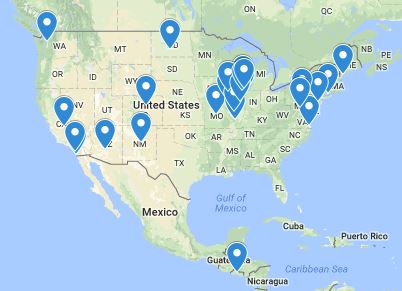
View an interactive map of internships in 2018

Get science-backed answers as you write with Paperpal's Research feature
How to Write a Research Paper Introduction (with Examples)

The research paper introduction section, along with the Title and Abstract, can be considered the face of any research paper. The following article is intended to guide you in organizing and writing the research paper introduction for a quality academic article or dissertation.
The research paper introduction aims to present the topic to the reader. A study will only be accepted for publishing if you can ascertain that the available literature cannot answer your research question. So it is important to ensure that you have read important studies on that particular topic, especially those within the last five to ten years, and that they are properly referenced in this section. 1 What should be included in the research paper introduction is decided by what you want to tell readers about the reason behind the research and how you plan to fill the knowledge gap. The best research paper introduction provides a systemic review of existing work and demonstrates additional work that needs to be done. It needs to be brief, captivating, and well-referenced; a well-drafted research paper introduction will help the researcher win half the battle.
The introduction for a research paper is where you set up your topic and approach for the reader. It has several key goals:
- Present your research topic
- Capture reader interest
- Summarize existing research
- Position your own approach
- Define your specific research problem and problem statement
- Highlight the novelty and contributions of the study
- Give an overview of the paper’s structure
The research paper introduction can vary in size and structure depending on whether your paper presents the results of original empirical research or is a review paper. Some research paper introduction examples are only half a page while others are a few pages long. In many cases, the introduction will be shorter than all of the other sections of your paper; its length depends on the size of your paper as a whole.
- Break through writer’s block. Write your research paper introduction with Paperpal Copilot
Table of Contents
What is the introduction for a research paper, why is the introduction important in a research paper, craft a compelling introduction section with paperpal. try now, 1. introduce the research topic:, 2. determine a research niche:, 3. place your research within the research niche:, craft accurate research paper introductions with paperpal. start writing now, frequently asked questions on research paper introduction, key points to remember.
The introduction in a research paper is placed at the beginning to guide the reader from a broad subject area to the specific topic that your research addresses. They present the following information to the reader
- Scope: The topic covered in the research paper
- Context: Background of your topic
- Importance: Why your research matters in that particular area of research and the industry problem that can be targeted
The research paper introduction conveys a lot of information and can be considered an essential roadmap for the rest of your paper. A good introduction for a research paper is important for the following reasons:
- It stimulates your reader’s interest: A good introduction section can make your readers want to read your paper by capturing their interest. It informs the reader what they are going to learn and helps determine if the topic is of interest to them.
- It helps the reader understand the research background: Without a clear introduction, your readers may feel confused and even struggle when reading your paper. A good research paper introduction will prepare them for the in-depth research to come. It provides you the opportunity to engage with the readers and demonstrate your knowledge and authority on the specific topic.
- It explains why your research paper is worth reading: Your introduction can convey a lot of information to your readers. It introduces the topic, why the topic is important, and how you plan to proceed with your research.
- It helps guide the reader through the rest of the paper: The research paper introduction gives the reader a sense of the nature of the information that will support your arguments and the general organization of the paragraphs that will follow. It offers an overview of what to expect when reading the main body of your paper.
What are the parts of introduction in the research?
A good research paper introduction section should comprise three main elements: 2
- What is known: This sets the stage for your research. It informs the readers of what is known on the subject.
- What is lacking: This is aimed at justifying the reason for carrying out your research. This could involve investigating a new concept or method or building upon previous research.
- What you aim to do: This part briefly states the objectives of your research and its major contributions. Your detailed hypothesis will also form a part of this section.
How to write a research paper introduction?
The first step in writing the research paper introduction is to inform the reader what your topic is and why it’s interesting or important. This is generally accomplished with a strong opening statement. The second step involves establishing the kinds of research that have been done and ending with limitations or gaps in the research that you intend to address. Finally, the research paper introduction clarifies how your own research fits in and what problem it addresses. If your research involved testing hypotheses, these should be stated along with your research question. The hypothesis should be presented in the past tense since it will have been tested by the time you are writing the research paper introduction.
The following key points, with examples, can guide you when writing the research paper introduction section:
- Highlight the importance of the research field or topic
- Describe the background of the topic
- Present an overview of current research on the topic
Example: The inclusion of experiential and competency-based learning has benefitted electronics engineering education. Industry partnerships provide an excellent alternative for students wanting to engage in solving real-world challenges. Industry-academia participation has grown in recent years due to the need for skilled engineers with practical training and specialized expertise. However, from the educational perspective, many activities are needed to incorporate sustainable development goals into the university curricula and consolidate learning innovation in universities.
- Reveal a gap in existing research or oppose an existing assumption
- Formulate the research question
Example: There have been plausible efforts to integrate educational activities in higher education electronics engineering programs. However, very few studies have considered using educational research methods for performance evaluation of competency-based higher engineering education, with a focus on technical and or transversal skills. To remedy the current need for evaluating competencies in STEM fields and providing sustainable development goals in engineering education, in this study, a comparison was drawn between study groups without and with industry partners.
- State the purpose of your study
- Highlight the key characteristics of your study
- Describe important results
- Highlight the novelty of the study.
- Offer a brief overview of the structure of the paper.
Example: The study evaluates the main competency needed in the applied electronics course, which is a fundamental core subject for many electronics engineering undergraduate programs. We compared two groups, without and with an industrial partner, that offered real-world projects to solve during the semester. This comparison can help determine significant differences in both groups in terms of developing subject competency and achieving sustainable development goals.
Write a Research Paper Introduction in Minutes with Paperpal
Paperpal Copilot is a generative AI-powered academic writing assistant. It’s trained on millions of published scholarly articles and over 20 years of STM experience. Paperpal Copilot helps authors write better and faster with:
- Real-time writing suggestions
- In-depth checks for language and grammar correction
- Paraphrasing to add variety, ensure academic tone, and trim text to meet journal limits
With Paperpal Copilot, create a research paper introduction effortlessly. In this step-by-step guide, we’ll walk you through how Paperpal transforms your initial ideas into a polished and publication-ready introduction.

How to use Paperpal to write the Introduction section
Step 1: Sign up on Paperpal and click on the Copilot feature, under this choose Outlines > Research Article > Introduction
Step 2: Add your unstructured notes or initial draft, whether in English or another language, to Paperpal, which is to be used as the base for your content.
Step 3: Fill in the specifics, such as your field of study, brief description or details you want to include, which will help the AI generate the outline for your Introduction.
Step 4: Use this outline and sentence suggestions to develop your content, adding citations where needed and modifying it to align with your specific research focus.
Step 5: Turn to Paperpal’s granular language checks to refine your content, tailor it to reflect your personal writing style, and ensure it effectively conveys your message.
You can use the same process to develop each section of your article, and finally your research paper in half the time and without any of the stress.
The purpose of the research paper introduction is to introduce the reader to the problem definition, justify the need for the study, and describe the main theme of the study. The aim is to gain the reader’s attention by providing them with necessary background information and establishing the main purpose and direction of the research.
The length of the research paper introduction can vary across journals and disciplines. While there are no strict word limits for writing the research paper introduction, an ideal length would be one page, with a maximum of 400 words over 1-4 paragraphs. Generally, it is one of the shorter sections of the paper as the reader is assumed to have at least a reasonable knowledge about the topic. 2 For example, for a study evaluating the role of building design in ensuring fire safety, there is no need to discuss definitions and nature of fire in the introduction; you could start by commenting upon the existing practices for fire safety and how your study will add to the existing knowledge and practice.
When deciding what to include in the research paper introduction, the rest of the paper should also be considered. The aim is to introduce the reader smoothly to the topic and facilitate an easy read without much dependency on external sources. 3 Below is a list of elements you can include to prepare a research paper introduction outline and follow it when you are writing the research paper introduction. Topic introduction: This can include key definitions and a brief history of the topic. Research context and background: Offer the readers some general information and then narrow it down to specific aspects. Details of the research you conducted: A brief literature review can be included to support your arguments or line of thought. Rationale for the study: This establishes the relevance of your study and establishes its importance. Importance of your research: The main contributions are highlighted to help establish the novelty of your study Research hypothesis: Introduce your research question and propose an expected outcome. Organization of the paper: Include a short paragraph of 3-4 sentences that highlights your plan for the entire paper
Cite only works that are most relevant to your topic; as a general rule, you can include one to three. Note that readers want to see evidence of original thinking. So it is better to avoid using too many references as it does not leave much room for your personal standpoint to shine through. Citations in your research paper introduction support the key points, and the number of citations depend on the subject matter and the point discussed. If the research paper introduction is too long or overflowing with citations, it is better to cite a few review articles rather than the individual articles summarized in the review. A good point to remember when citing research papers in the introduction section is to include at least one-third of the references in the introduction.
The literature review plays a significant role in the research paper introduction section. A good literature review accomplishes the following: Introduces the topic – Establishes the study’s significance – Provides an overview of the relevant literature – Provides context for the study using literature – Identifies knowledge gaps However, remember to avoid making the following mistakes when writing a research paper introduction: Do not use studies from the literature review to aggressively support your research Avoid direct quoting Do not allow literature review to be the focus of this section. Instead, the literature review should only aid in setting a foundation for the manuscript.
Remember the following key points for writing a good research paper introduction: 4
- Avoid stuffing too much general information: Avoid including what an average reader would know and include only that information related to the problem being addressed in the research paper introduction. For example, when describing a comparative study of non-traditional methods for mechanical design optimization, information related to the traditional methods and differences between traditional and non-traditional methods would not be relevant. In this case, the introduction for the research paper should begin with the state-of-the-art non-traditional methods and methods to evaluate the efficiency of newly developed algorithms.
- Avoid packing too many references: Cite only the required works in your research paper introduction. The other works can be included in the discussion section to strengthen your findings.
- Avoid extensive criticism of previous studies: Avoid being overly critical of earlier studies while setting the rationale for your study. A better place for this would be the Discussion section, where you can highlight the advantages of your method.
- Avoid describing conclusions of the study: When writing a research paper introduction remember not to include the findings of your study. The aim is to let the readers know what question is being answered. The actual answer should only be given in the Results and Discussion section.
To summarize, the research paper introduction section should be brief yet informative. It should convince the reader the need to conduct the study and motivate him to read further. If you’re feeling stuck or unsure, choose trusted AI academic writing assistants like Paperpal to effortlessly craft your research paper introduction and other sections of your research article.
1. Jawaid, S. A., & Jawaid, M. (2019). How to write introduction and discussion. Saudi Journal of Anaesthesia, 13(Suppl 1), S18.
2. Dewan, P., & Gupta, P. (2016). Writing the title, abstract and introduction: Looks matter!. Indian pediatrics, 53, 235-241.
3. Cetin, S., & Hackam, D. J. (2005). An approach to the writing of a scientific Manuscript1. Journal of Surgical Research, 128(2), 165-167.
4. Bavdekar, S. B. (2015). Writing introduction: Laying the foundations of a research paper. Journal of the Association of Physicians of India, 63(7), 44-6.
Paperpal is a comprehensive AI writing toolkit that helps students and researchers achieve 2x the writing in half the time. It leverages 21+ years of STM experience and insights from millions of research articles to provide in-depth academic writing, language editing, and submission readiness support to help you write better, faster.
Get accurate academic translations, rewriting support, grammar checks, vocabulary suggestions, and generative AI assistance that delivers human precision at machine speed. Try for free or upgrade to Paperpal Prime starting at US$19 a month to access premium features, including consistency, plagiarism, and 30+ submission readiness checks to help you succeed.
Experience the future of academic writing – Sign up to Paperpal and start writing for free!
Related Reads:
- Scientific Writing Style Guides Explained
- 5 Reasons for Rejection After Peer Review
- Ethical Research Practices For Research with Human Subjects
- 8 Most Effective Ways to Increase Motivation for Thesis Writing
Practice vs. Practise: Learn the Difference
Academic paraphrasing: why paperpal’s rewrite should be your first choice , you may also like, mla works cited page: format, template & examples, how to write a high-quality conference paper, academic editing: how to self-edit academic text with..., measuring academic success: definition & strategies for excellence, phd qualifying exam: tips for success , ai in education: it’s time to change the..., is it ethical to use ai-generated abstracts without..., what are journal guidelines on using generative ai..., quillbot review: features, pricing, and free alternatives, what is an academic paper types and elements .
- Privacy Policy

Home » Research Methodology – Types, Examples and writing Guide
Research Methodology – Types, Examples and writing Guide
Table of Contents

Research Methodology
Definition:
Research Methodology refers to the systematic and scientific approach used to conduct research, investigate problems, and gather data and information for a specific purpose. It involves the techniques and procedures used to identify, collect , analyze , and interpret data to answer research questions or solve research problems . Moreover, They are philosophical and theoretical frameworks that guide the research process.
Structure of Research Methodology
Research methodology formats can vary depending on the specific requirements of the research project, but the following is a basic example of a structure for a research methodology section:
I. Introduction
- Provide an overview of the research problem and the need for a research methodology section
- Outline the main research questions and objectives
II. Research Design
- Explain the research design chosen and why it is appropriate for the research question(s) and objectives
- Discuss any alternative research designs considered and why they were not chosen
- Describe the research setting and participants (if applicable)
III. Data Collection Methods
- Describe the methods used to collect data (e.g., surveys, interviews, observations)
- Explain how the data collection methods were chosen and why they are appropriate for the research question(s) and objectives
- Detail any procedures or instruments used for data collection
IV. Data Analysis Methods
- Describe the methods used to analyze the data (e.g., statistical analysis, content analysis )
- Explain how the data analysis methods were chosen and why they are appropriate for the research question(s) and objectives
- Detail any procedures or software used for data analysis
V. Ethical Considerations
- Discuss any ethical issues that may arise from the research and how they were addressed
- Explain how informed consent was obtained (if applicable)
- Detail any measures taken to ensure confidentiality and anonymity
VI. Limitations
- Identify any potential limitations of the research methodology and how they may impact the results and conclusions
VII. Conclusion
- Summarize the key aspects of the research methodology section
- Explain how the research methodology addresses the research question(s) and objectives
Research Methodology Types
Types of Research Methodology are as follows:
Quantitative Research Methodology
This is a research methodology that involves the collection and analysis of numerical data using statistical methods. This type of research is often used to study cause-and-effect relationships and to make predictions.
Qualitative Research Methodology
This is a research methodology that involves the collection and analysis of non-numerical data such as words, images, and observations. This type of research is often used to explore complex phenomena, to gain an in-depth understanding of a particular topic, and to generate hypotheses.
Mixed-Methods Research Methodology
This is a research methodology that combines elements of both quantitative and qualitative research. This approach can be particularly useful for studies that aim to explore complex phenomena and to provide a more comprehensive understanding of a particular topic.
Case Study Research Methodology
This is a research methodology that involves in-depth examination of a single case or a small number of cases. Case studies are often used in psychology, sociology, and anthropology to gain a detailed understanding of a particular individual or group.
Action Research Methodology
This is a research methodology that involves a collaborative process between researchers and practitioners to identify and solve real-world problems. Action research is often used in education, healthcare, and social work.
Experimental Research Methodology
This is a research methodology that involves the manipulation of one or more independent variables to observe their effects on a dependent variable. Experimental research is often used to study cause-and-effect relationships and to make predictions.
Survey Research Methodology
This is a research methodology that involves the collection of data from a sample of individuals using questionnaires or interviews. Survey research is often used to study attitudes, opinions, and behaviors.
Grounded Theory Research Methodology
This is a research methodology that involves the development of theories based on the data collected during the research process. Grounded theory is often used in sociology and anthropology to generate theories about social phenomena.
Research Methodology Example
An Example of Research Methodology could be the following:
Research Methodology for Investigating the Effectiveness of Cognitive Behavioral Therapy in Reducing Symptoms of Depression in Adults
Introduction:
The aim of this research is to investigate the effectiveness of cognitive-behavioral therapy (CBT) in reducing symptoms of depression in adults. To achieve this objective, a randomized controlled trial (RCT) will be conducted using a mixed-methods approach.
Research Design:
The study will follow a pre-test and post-test design with two groups: an experimental group receiving CBT and a control group receiving no intervention. The study will also include a qualitative component, in which semi-structured interviews will be conducted with a subset of participants to explore their experiences of receiving CBT.
Participants:
Participants will be recruited from community mental health clinics in the local area. The sample will consist of 100 adults aged 18-65 years old who meet the diagnostic criteria for major depressive disorder. Participants will be randomly assigned to either the experimental group or the control group.
Intervention :
The experimental group will receive 12 weekly sessions of CBT, each lasting 60 minutes. The intervention will be delivered by licensed mental health professionals who have been trained in CBT. The control group will receive no intervention during the study period.
Data Collection:
Quantitative data will be collected through the use of standardized measures such as the Beck Depression Inventory-II (BDI-II) and the Generalized Anxiety Disorder-7 (GAD-7). Data will be collected at baseline, immediately after the intervention, and at a 3-month follow-up. Qualitative data will be collected through semi-structured interviews with a subset of participants from the experimental group. The interviews will be conducted at the end of the intervention period, and will explore participants’ experiences of receiving CBT.
Data Analysis:
Quantitative data will be analyzed using descriptive statistics, t-tests, and mixed-model analyses of variance (ANOVA) to assess the effectiveness of the intervention. Qualitative data will be analyzed using thematic analysis to identify common themes and patterns in participants’ experiences of receiving CBT.
Ethical Considerations:
This study will comply with ethical guidelines for research involving human subjects. Participants will provide informed consent before participating in the study, and their privacy and confidentiality will be protected throughout the study. Any adverse events or reactions will be reported and managed appropriately.
Data Management:
All data collected will be kept confidential and stored securely using password-protected databases. Identifying information will be removed from qualitative data transcripts to ensure participants’ anonymity.
Limitations:
One potential limitation of this study is that it only focuses on one type of psychotherapy, CBT, and may not generalize to other types of therapy or interventions. Another limitation is that the study will only include participants from community mental health clinics, which may not be representative of the general population.
Conclusion:
This research aims to investigate the effectiveness of CBT in reducing symptoms of depression in adults. By using a randomized controlled trial and a mixed-methods approach, the study will provide valuable insights into the mechanisms underlying the relationship between CBT and depression. The results of this study will have important implications for the development of effective treatments for depression in clinical settings.
How to Write Research Methodology
Writing a research methodology involves explaining the methods and techniques you used to conduct research, collect data, and analyze results. It’s an essential section of any research paper or thesis, as it helps readers understand the validity and reliability of your findings. Here are the steps to write a research methodology:
- Start by explaining your research question: Begin the methodology section by restating your research question and explaining why it’s important. This helps readers understand the purpose of your research and the rationale behind your methods.
- Describe your research design: Explain the overall approach you used to conduct research. This could be a qualitative or quantitative research design, experimental or non-experimental, case study or survey, etc. Discuss the advantages and limitations of the chosen design.
- Discuss your sample: Describe the participants or subjects you included in your study. Include details such as their demographics, sampling method, sample size, and any exclusion criteria used.
- Describe your data collection methods : Explain how you collected data from your participants. This could include surveys, interviews, observations, questionnaires, or experiments. Include details on how you obtained informed consent, how you administered the tools, and how you minimized the risk of bias.
- Explain your data analysis techniques: Describe the methods you used to analyze the data you collected. This could include statistical analysis, content analysis, thematic analysis, or discourse analysis. Explain how you dealt with missing data, outliers, and any other issues that arose during the analysis.
- Discuss the validity and reliability of your research : Explain how you ensured the validity and reliability of your study. This could include measures such as triangulation, member checking, peer review, or inter-coder reliability.
- Acknowledge any limitations of your research: Discuss any limitations of your study, including any potential threats to validity or generalizability. This helps readers understand the scope of your findings and how they might apply to other contexts.
- Provide a summary: End the methodology section by summarizing the methods and techniques you used to conduct your research. This provides a clear overview of your research methodology and helps readers understand the process you followed to arrive at your findings.
When to Write Research Methodology
Research methodology is typically written after the research proposal has been approved and before the actual research is conducted. It should be written prior to data collection and analysis, as it provides a clear roadmap for the research project.
The research methodology is an important section of any research paper or thesis, as it describes the methods and procedures that will be used to conduct the research. It should include details about the research design, data collection methods, data analysis techniques, and any ethical considerations.
The methodology should be written in a clear and concise manner, and it should be based on established research practices and standards. It is important to provide enough detail so that the reader can understand how the research was conducted and evaluate the validity of the results.
Applications of Research Methodology
Here are some of the applications of research methodology:
- To identify the research problem: Research methodology is used to identify the research problem, which is the first step in conducting any research.
- To design the research: Research methodology helps in designing the research by selecting the appropriate research method, research design, and sampling technique.
- To collect data: Research methodology provides a systematic approach to collect data from primary and secondary sources.
- To analyze data: Research methodology helps in analyzing the collected data using various statistical and non-statistical techniques.
- To test hypotheses: Research methodology provides a framework for testing hypotheses and drawing conclusions based on the analysis of data.
- To generalize findings: Research methodology helps in generalizing the findings of the research to the target population.
- To develop theories : Research methodology is used to develop new theories and modify existing theories based on the findings of the research.
- To evaluate programs and policies : Research methodology is used to evaluate the effectiveness of programs and policies by collecting data and analyzing it.
- To improve decision-making: Research methodology helps in making informed decisions by providing reliable and valid data.
Purpose of Research Methodology
Research methodology serves several important purposes, including:
- To guide the research process: Research methodology provides a systematic framework for conducting research. It helps researchers to plan their research, define their research questions, and select appropriate methods and techniques for collecting and analyzing data.
- To ensure research quality: Research methodology helps researchers to ensure that their research is rigorous, reliable, and valid. It provides guidelines for minimizing bias and error in data collection and analysis, and for ensuring that research findings are accurate and trustworthy.
- To replicate research: Research methodology provides a clear and detailed account of the research process, making it possible for other researchers to replicate the study and verify its findings.
- To advance knowledge: Research methodology enables researchers to generate new knowledge and to contribute to the body of knowledge in their field. It provides a means for testing hypotheses, exploring new ideas, and discovering new insights.
- To inform decision-making: Research methodology provides evidence-based information that can inform policy and decision-making in a variety of fields, including medicine, public health, education, and business.

Advantages of Research Methodology
Research methodology has several advantages that make it a valuable tool for conducting research in various fields. Here are some of the key advantages of research methodology:
- Systematic and structured approach : Research methodology provides a systematic and structured approach to conducting research, which ensures that the research is conducted in a rigorous and comprehensive manner.
- Objectivity : Research methodology aims to ensure objectivity in the research process, which means that the research findings are based on evidence and not influenced by personal bias or subjective opinions.
- Replicability : Research methodology ensures that research can be replicated by other researchers, which is essential for validating research findings and ensuring their accuracy.
- Reliability : Research methodology aims to ensure that the research findings are reliable, which means that they are consistent and can be depended upon.
- Validity : Research methodology ensures that the research findings are valid, which means that they accurately reflect the research question or hypothesis being tested.
- Efficiency : Research methodology provides a structured and efficient way of conducting research, which helps to save time and resources.
- Flexibility : Research methodology allows researchers to choose the most appropriate research methods and techniques based on the research question, data availability, and other relevant factors.
- Scope for innovation: Research methodology provides scope for innovation and creativity in designing research studies and developing new research techniques.
Research Methodology Vs Research Methods
About the author.
Muhammad Hassan
Researcher, Academic Writer, Web developer
You may also like

How to Cite Research Paper – All Formats and...

Data Collection – Methods Types and Examples

Delimitations in Research – Types, Examples and...

Research Paper Format – Types, Examples and...

Research Process – Steps, Examples and Tips

Research Design – Types, Methods and Examples
What’s Included: Research Proposal Template
Our free dissertation/thesis proposal template covers the core essential ingredients for a strong research proposal. It includes clear explanations of what you need to address in each section, as well as straightforward examples and links to further resources.
The research proposal template covers the following core elements:
- Introduction & background (including the research problem)
- Literature review
- Research design / methodology
- Project plan , resource requirements and risk management
The cleanly-formatted Google Doc can be downloaded as a fully editable MS Word Document (DOCX format), so you can use it as-is or convert it to LaTeX.
PS – if you’d like a high-level template for the entire thesis, you can we’ve got that too .
Research Proposal Template FAQS
What types of research proposals can this template be used for.
The proposal template follows the standard format for academic research projects, which means it will be suitable for the vast majority of dissertations and theses (especially those within the sciences), whether they are qualitative or quantitative in terms of design.
Keep in mind that the exact requirements for the introduction chapter/section will vary between universities and degree programs. These are typically minor, but it’s always a good idea to double-check your university’s requirements before you finalise your structure.
Is this template for an undergrad, Master or PhD-level proposal?
This template can be used for a research project at any level of study. Doctoral-level projects typically require the research proposal to be more extensive/comprehensive, but the structure will typically remain the same.
How long should my research proposal be?
The length of a research proposal varies by institution and subject, but as a ballpark, it’s usually between 1,500 and 3,000 words.
To be safe, it’s best to check with your university if they have any preferences or requirements in terms of minimum and maximum word count for the research propsal.
How detailed should the methodology of the proposal be?
You don’t need to go into the fine details of your methodology, but this section should be detailed enough to demonstrate that your research approach is feasible and will address your research questions effectively. Be sure to include your intended methods for data collection and analysis.
Can I include preliminary data or pilot study results in my proposal?
Generally, yes. This can strengthen your proposal by demonstrating the feasibility of your research. However, make sure that your pilot study is approved by your university before collecting any data.
Can I share this template with my friends/colleagues?
Yes, you’re welcome to share this template in its original format (no editing allowed). If you want to post about it on your blog or social media, we kindly request that you reference this page as your source.
What format is the template (DOC, PDF, PPT, etc.)?
The research proposal template is provided as a Google Doc. You can download it in MS Word format or make a copy to your Google Drive. You’re also welcome to convert it to whatever format works best for you, such as LaTeX or PDF.
Do you have templates for the other chapters?
Yes, we do. We are constantly developing our collection of free resources to help students complete their dissertations and theses. You can view all of our template resources here .
Can Grad Coach help me with my dissertation/thesis?
Yes, you’re welcome to get in touch with us to discuss our private coaching services .
Further Resources: Proposal Writing
The template provides step-by-step guidance for each section of your research proposal, but if you’d like to learn more about how to write up a high-quality research proposal, check out the rest of our free proposal-related resources:
- Research Proposal 101
- Examples of research proposals
- How To Find A Research Topic
- How To Find A Research Gap
- Developing Your Golden Thread
- How To Write A Research Proposal
- 8 Common Proposal Writing Mistakes
You can also visit the Grad Coach blog for more proposal-related resources.

If you’d prefer 1-on-1 support with your research proposal, have a look at our private coaching service , where we hold your hand through the research process, step by step.
- Support Our Work
The Smithsonian Institution's Human Origins Program
- Teaching Evolution through Human Examples

The "Teaching Evolution through Human Examples" (TEtHE) three-year exploratory research and development project was funded by National Science Foundation Discovery Research K-12 grant #1119468. The project has created four curriculum units for Advanced Placement (AP) Biology classes, aligned to the learning objectives, using human case studies to teach core evolutionary principles. The curriculum units are: (1) Adaptation to Altitude, (2) Malaria, (3) Evolution of Human Skin Color, and (4) What Does It Mean To Be Human?. The project has also created a CRS (Cultural and Religious Sensitivity) Teaching Strategies Resource to help teachers create a comfortable and supportive classroom environment for teaching evolution. More information about the project can be found here. Any opinions, findings, and conclusions or recommendations expressed in this material are those of the author(s) and do not necessarily reflect the views of the National Science Foundation.
All of our resources are downloadable here for free!
Click on this link: bit.ly/TeachHumanEvolution
You can also read two research articles in the journal Evolution: Education and Outreach, one published in April 2018 and one published in January 2019 , about the effectiveness of these materials.
CURRICULUM UNITS
The curriculum units contain 4-5 lessons and are designed to be taught over 5-9 days (depending on the unit, whether or not the FULL or CONDENSED lessons are used, and whether or not optional steps are included. Each version has an accompanying powerpoint file for teaching purposes and a student workbook where all student handouts are collated.

Adaptation to Altitude: Students learn how to devise an experiment to test the difference between acclimation and adaptation; investigate how scientific arguments show support for natural selection in Tibetans; design an investigation using a simulation based on the Hardy-Weinberg principle to explore mechanisms of evolution; and devise a test for whether other groups of people have adapted to living at high altitudes.

Evolution of Human Skin Color: Students examine evidence for the relationship between UV and melanin in other animals; investigate the genetic basis for constitutive skin color humans; learn to test for natural selection in mouse fur color; investigate how interactions between UV and skin color in humans can affect fitness; design an investigation using a simulation based on the Hardy-Weinberg principle to explore mechanisms of evolution; and explore data on migrations and gene frequency to show convergent evolution of skin color.

Malaria: Students examine evidence to compare four different explanations for why many malarial parasites are resistant to antimalarial drugs; investigate how scientific arguments using G6PD data show support for natural selection in humans; design an investigation using a simulation based on the Hardy-Weinberg principle to explore mechanisms of evolution; and apply their understanding to other alleles that have evolved in response to malaria.

What Does It Mean to be Human?: Using a strong nature of science component, students use different types of data to infer / interpret phylogenies among domains, within the vertebrates, and within primates while reflecting on how they answer the question “What do you think it means to be human?” and choose a characteristic that changed substantially in the human family tree to develop a scientific argument based on evidence for when the character evolved.

CRS (CULTURAL AND RELIGIOUS SENSITIVITY) TEACHING STRATEGIES RESOURCE
Description:
The Cultural and Religious Sensitivity (CRS) Teaching Strategies Resource is intended to help create a nonthreatening classroom environment where an opportunity for understanding the scientific account of evolution is possible, and to both encourage and help equip high school teachers to promote positive dialogue around the topic of evolution in their classrooms. The CRS resource complements the TEtHE curriculum units created for AP high school biology courses. However, the CRS resource should also prove valuable for use with general introductory biology students.
Part 1 provides concise foundational information on topics including insight into the nature of science as pertinent to managing a conflict between science and religion; the range of creationists views; the variety of possible relationships between science and religion including examples of how individuals accommodate evolution and religion; and the historical context and background on legal cases dealing with the teaching of evolution. For teachers seeking a proactive approach that acknowledges the cultural and religious controversies and encourages a classroom exploration of the impact of these controversies on the understanding of evolution, Part 2 provides activities to engage students in two 50-75 minute directed classroom discussions. Each classroom activity has an accompanying powerpoint file for teaching purposes.
Classroom Activity 1 , Directed Discussions: “Why Study Evolution” , is designed to be used at the start of instruction on evolutionary theory in classrooms where teachers are aware that many of their students have been exposed to only negative and/or mistaken notions of evolutionary theory and to provide an opportunity for students’ concerns to be acknowledged.
Activity 1 feedback:
(teacher) "This was the first time I have taken class time to address the question 'Why study evolution?". In years past, I took for granted that everyone would be on board, and if they were not there was not much I could do about it. I appreciate the way this structured lesson helped me slow down and acknowledge that certain people have doubts about the evidence for evolution. Those doubts should not have to be muffled. There is space for such dialogue, without diminishing the significance of evolution to the study of biology".
(student) "It just kind of brought you to think about what your views on evolution are because I'm pretty devoutly religious. It was interesting to think about like, how my beliefs can mesh with evolution and I could still believe in science."
(student) "I really like how the lessons ease you into evolution, the idea of it, because most people are not open to learning it, so it's kind of helping you not to have to be bombarded..."
Classroom Activity 2 , A Historical Role Play: “How Do People Think about Evolutionary Theory” , is designed to be used at the end of the instruction on evolution, and to reinforce that instruction, in classrooms where teachers believe that anti-evolutionism is a non-existent or minority viewpoint.
Activity 2 feedback:
(student) "I was a little concerned at first because I knew a little bit of background about this debate and I knew it would have a lot of religion in it and I'm religious myself so I was a little worried about people bashing my views, but it didn't really get to that so I was happy."
(student) "It was interesting to have to defend a point of view that you might not agree with in your everyday opinions. It just makes you think about the different views and like how you could like see how that could work but from the modern standpoint that we had to do, how it could be wrong."
(student) "I considered it a little bit of a capstone because we learned about evolution and then we had to put in what our current response would be to theirs so we had to formulate our own kind of argument based on what we have already learned..."
RESEARCH AND IMPLEMENTATION SUMMARY
The curriculum units were reviewed by teachers, other educators, and scientists, field tested (round 1) by 5 teachers, revised, and then field tested (round 2) by 15 teachers and 470 students in 10 states across the US. Our preliminary results indicate that the curriculum units increased understanding of, attitude towards, and interest in evolution. Most of the students surveyed indicated that they enjoyed learning about evolution through human examples as much or more than using other examples. The CRS resource was field tested by a subset of 8 of the curriculum unit field test teachers and 160 students, and we found a greater effect on students understanding of evolution for those students who experienced one of the in-class CRS activities.
We are very grateful to our field test teachers and their students! Thanks to: Sydney Bergman, Lisa Boyer, Christy Clark, Donna Considine, Melissa Csikari, Frank Fitzgibbon, Matthew Foret, Lauren Fuller, Cindy Gay, David Knuffke, Alison Loeper, Melinda Malcore, Susan Park, Eileen Pascucci, Tamara Pennington, Phyllis Robinson, Jennifer Shake, and Suzanne Sikes.
We are also grateful to our expert educators: Nikki Chambers (West High School, CA); Chelsea Crawford (Fremont Union High School District, CA); Mark Terry (The Northwest School, WA); Brad Williamson (UKanTeach Program, KS), and David Pinkerton (independent educational consultant) - and scientists: Cynthia Beall (Case Western University); Holly Dunsworth (University of Rhode Island); Carla Easter (NGHRI); Nina Jablonski (Pennsylvania State University); and Mark Schwartz (NYU School of Medicine) for reviewing multiple versions of our curriculum units.
We are also grateful to Jennifer Clark (Illustrator), Norma Oldfield (illustration research assistant), Anna Ragni (Illustration research assistant), and Matthew Ferry (data collection and entry assistant).
PROJECT PERSONNEL
Project PI is Briana Pobiner (Smithsonian Institution), and project co-PIs are Rick Potts (Smithsonian Institution) and Bill Watson (Diocese of Camden Office of Catholic Schools).
Senior Personnel are Paul Beardsley (Cal Poly Pomona - author of curriculum units); Connie Bertka (Science and Society Resources - author of CRS Resource); and Jay Labov (National Academy of Sciences) and the National Academy of Sciences Teacher Advisory Council; Christopher Lazzaro (College Board); and Kathryn Race (Race and Associates - project evaluator).
Advisory Board members are: Jennifer Bricken (Howard Hughes Medical Institute); Juliet Crowell (Smithsonian Institution); Dennis Liu (Howard Hughes Medical Institute); David Long (George Mason University); Sharon Lynch (George Washington University); Lee Meadows (University of Alabama at Birmingham); and Anna Thanukos (UCMP Berkeley).
- Climate Effects on Human Evolution
- Survival of the Adaptable
- Human Evolution Timeline Interactive
- 2011 Olorgesailie Dispatches
- 2004 Olorgesailie Dispatches
- 1999 Olorgesailie Dispatches
- Olorgesailie Drilling Project
- Kanam, Kenya
- Kanjera, Kenya
- Ol Pejeta, Kenya
- Olorgesailie, Kenya
- Evolution of Human Innovation
- Adventures in the Rift Valley: Interactive
- 'Hobbits' on Flores, Indonesia
- Earliest Humans in China
- Bose, China
- Anthropocene: The Age of Humans
- Fossil Forensics: Interactive
- What's Hot in Human Origins?
- Instructions
- Carnivore Dentition
- Ungulate Dentition
- Primate Behavior
- Footprints from Koobi Fora, Kenya
- Laetoli Footprint Trails
- Footprints from Engare Sero, Tanzania
- Hammerstone from Majuangou, China
- Handaxe and Tektites from Bose, China
- Handaxe from Europe
- Handaxe from India
- Oldowan Tools from Lokalalei, Kenya
- Olduvai Chopper
- Stone Tools from Majuangou, China
- Middle Stone Age Tools
- Burin from Laugerie Haute & Basse, Dordogne, France
- La Madeleine, Dordogne, France
- Butchered Animal Bones from Gona, Ethiopia
- Katanda Bone Harpoon Point
- Oldest Wooden Spear
- Punctured Horse Shoulder Blade
- Stone Sickle Blades
- Projectile Point
- Oldest Pottery
- Pottery Fragment
- Fire-Altered Stone Tools
- Terra Amata Shelter
- Qafzeh: Oldest Intentional Burial
- Assyrian Cylinder Seal
- Blombos Ocher Plaque
- Ishango Bone
- Bone and Ivory Needles
- Carved Ivory Running Lion
- Female torso in ivory
- Ivory Horse Figurine
- Ivory Horse Sculpture
- Lady of Brassempouy
- Lion-Man Figurine
- Willendorf Venus
- Ancient Shell Beads
- Carved Bone Disc
- Cro-Magnon Shell Bead Necklace
- Oldest Known Shell Beads
- Ancient Flute
- Ancient Pigments
- Apollo 11 Plaque
- Carved antler baton with horses
- Geometric incised bone rectangle
- Tata Plaque
- Mystery Skull Interactive
- Shanidar 3 - Neanderthal Skeleton
- One Species, Living Worldwide
- Human Skin Color Variation
- Ancient DNA and Neanderthals
- Human Family Tree
- Swartkrans, South Africa
- Shanidar, Iraq
- Walking Upright
- Tools & Food
- Social Life
- Language & Symbols
- Humans Change the World
- Introduction to Human Evolution
- Nuts and bolts classification: Arbitrary or not? (Grades 6-8)
- Comparison of Human and Chimp Chromosomes (Grades 9-12)
- Hominid Cranial Comparison: The "Skulls" Lab (Grades 9-12)
- Investigating Common Descent: Formulating Explanations and Models (Grades 9-12)
- Fossil and Migration Patterns in Early Hominids (Grades 9-12)
- For College Students
- Why do we get goose bumps?
- Chickens, chimpanzees, and you - what do they have in common?
- Grandparents are unique to humans
- How strong are we?
- Humans are handy!
- Humans: the running ape
- Our big hungry brain!
- Our eyes say it!
- The early human tool kit
- The short-haired human!
- The “Nutcracker”
- What can lice tell us about human evolution?
- What does gut got to do with it?
- Why do paleoanthropologists love Lucy?
- Why do we have wisdom teeth?
- Human Origins Glossary
- Frequently Asked Questions
- Recommended Books
- Exhibit Floorplan Interactive
- Print Floorplan PDF
- Reconstructions of Early Humans
- Chesterfield County Public Library
- Orange County Library
- Andover Public Library
- Ephrata Public Library
- Oelwein Public Library
- Cedar City Public Library
- Milpitas Library
- Spokane County Library
- Cottage Grove Public Library
- Pueblo City-County Library
- Springfield-Greene County Library
- Peoria Public Library
- Orion Township Public Library
- Skokie Public Library
- Wyckoff Free Public Library
- Tompkins County Public Library
- Otis Library
- Fletcher Free Library
- Bangor Public Library
- Human Origins Do it Yourself Exhibit
- Exhibit Field Trip Guide
- Acknowledgments
- Human Origins Program Team
- Connie Bertka
- Betty Holley
- Nancy Howell
- Lee Meadows
- Jamie L. Jensen
- David Orenstein
- Michael Tenneson
- Leonisa Ardizzone
- David Haberman
- Fred Edwords (Emeritus)
- Elliot Dorff (Emeritus)
- Francisca Cho (Emeritus)
- Peter F. Ryan (Emeritus)
- Mustansir Mir (Emeritus)
- Randy Isaac (Emeritus)
- Mary Evelyn Tucker (Emeritus)
- Wentzel van Huyssteen (Emeritus)
- Joe Watkins (Emeritus)
- Tom Weinandy (Emeritus)
- Members Thoughts on Science, Religion & Human Origins (video)
- Science, Religion, Evolution and Creationism: Primer
- The Evolution of Religious Belief: Seeking Deep Evolutionary Roots
- Laboring for Science, Laboring for Souls: Obstacles and Approaches to Teaching and Learning Evolution in the Southeastern United States
- Public Event : Religious Audiences and the Topic of Evolution: Lessons from the Classroom (video)
- Evolution and the Anthropocene: Science, Religion, and the Human Future
- Imagining the Human Future: Ethics for the Anthropocene
- Human Evolution and Religion: Questions and Conversations from the Hall of Human Origins
- I Came from Where? Approaching the Science of Human Origins from Religious Perspectives
- Religious Perspectives on the Science of Human Origins
- Submit Your Response to "What Does It Mean To Be Human?"
- Volunteer Opportunities
- Submit Question
- "Shaping Humanity: How Science, Art, and Imagination Help Us Understand Our Origins" (book by John Gurche)
- What Does It Mean To Be Human? (book by Richard Potts and Chris Sloan)
- Bronze Statues
- Reconstructed Faces

Project Budget
Ai generator.

Preparing a budget for a future project is one of the most efficient methods to calculate the estimated cost of that project. The project budget document includes cost like materials cost, procurement cost & transportation freight, storage cost, operating cost, electricity cost, labor wages, and other costs according to the type of the project. Such a budget can also be considered as a dynamic document because it is modified with the course of the project. In-charges and managers are hired to monitor that the commenced project sticks to the estimated budget. In general, a project budget helps in defining the maximum fund required for implementing a project.
This article will cover instructions, reports, templates, summaries, and examples related to the project budget. One can download suitable templates and use reports for understanding & research purposes.
Project Budget Examples & Templates
Project budget template.
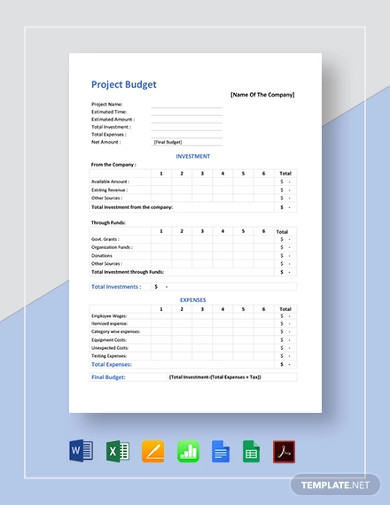
- Google Docs
- Google Sheets
- Editable PDF
Size: A4 & US
Are you looking for a template with a professional format for preparing a project budget? This file will help you prepare a project budget in just no time after your statistical research. The template is divided into Investment and Expenses section to efficiently calculate a budget. The file is available for download in seven file formats and can be conveniently customized as required. One can also send the editable PDF file to the concerned authorities for generating multiple budgets for comparison.
Monthly Project Budget Template
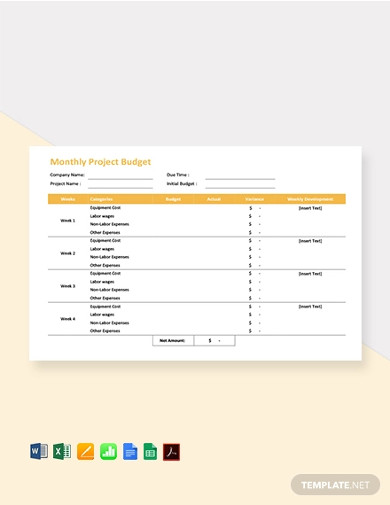
Preparing a monthly budget for a project helps in tracking the flow of money at the micro level. It also enables the managers to track the speed of the project and implement changes whenever required. This file is an example of the monthly budget template available for download in multiple formats. The format has divided the expenses into weeks for simplifying the calculation and better understanding. Download this template and prepare your monthly project budget.
Construction Project Budget
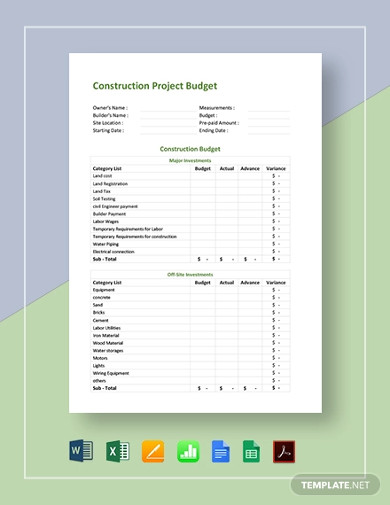
A construction project involves humongous funds. It becomes mandatory for the builders to accurately channelise funds so that the project can conclude on time and in the decided budget. This document is a two-page template of the construction project budget. It is easy to edit and divided into four sections for convenient budgeting.
Project Plan Budget Template
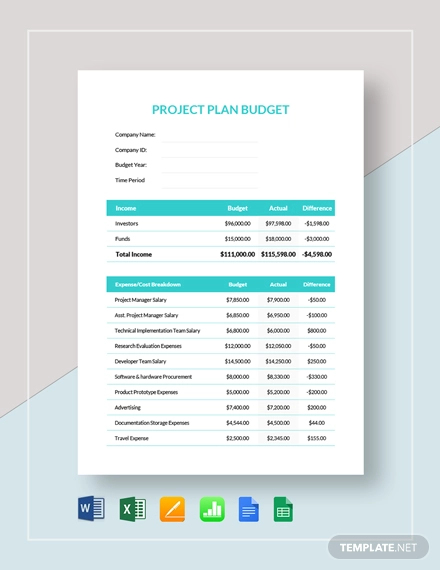
Project Budget Estimate Template
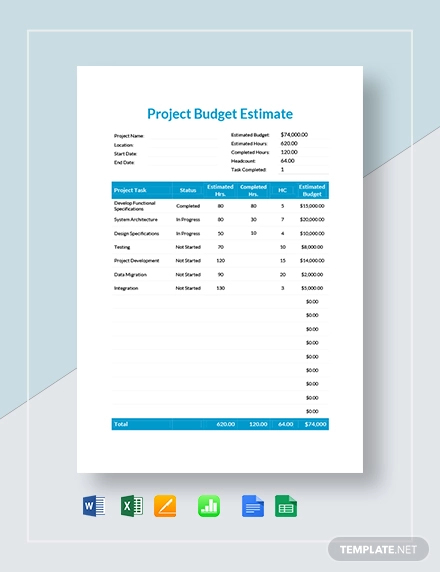
Construction Project Budget Tracking Template
Research Project Budget Template
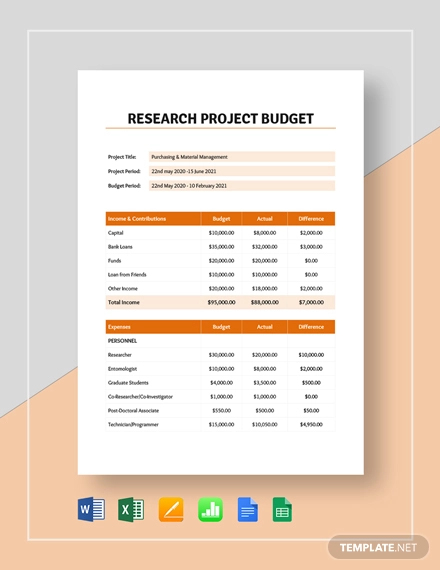
Free Basic Project Budget
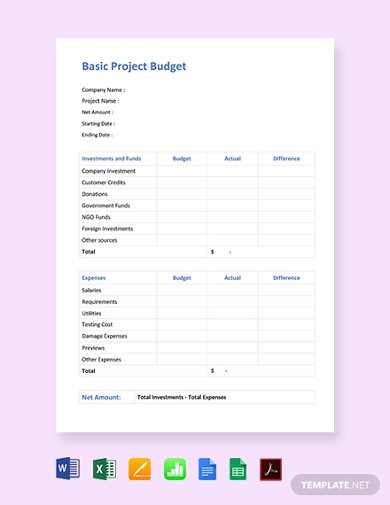
Free Download
Any small or big project can conclude with exceptional results if the budgeting is done efficiently. The above file is a project budget template in a general format. It is divided into two sections viz. Investment, Funds and Expenses. One has the option to download this template in multiple formats and customize according to the demand of the project.
Project Budget Management

Size: 254 KB
This file is a twenty-eight-page report on methodology to manage development projects for international humanitarian assistance and relief organizations. The report emphasizes and explains about controlling the project budget throughout the entire project life cycle. Download this report to learn and explore the fundamentals of project budget management.
Sample Project Budget
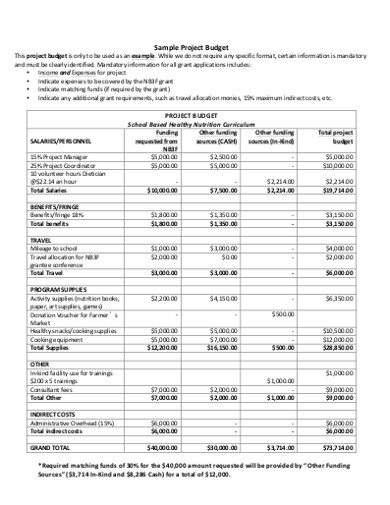
Size: 132 KB
The above document is a sample project budget of School-based healthy nutrition curriculum. It is advised that this budget should only be used as an example and for no other purposes. The budget is divided into multiple sections for convenience in understanding and fund allocations. Download this example to study efficient project budgeting.
Project Budget Example
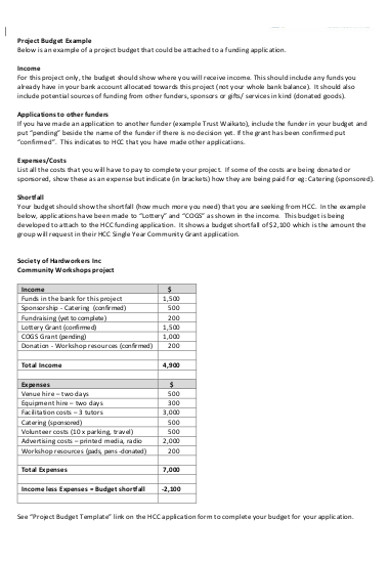
Size: 194 KB
This file is an example of a community workshop project budget. The document guides the readers about important things to keep in mind while drafting a budget . It focuses on mandatorily adding a shortfall to the total budget by explaining the necessity of the same. Download this example and quickly review important parameters of focus for preparing a project budget.
Introduction to Project Budget
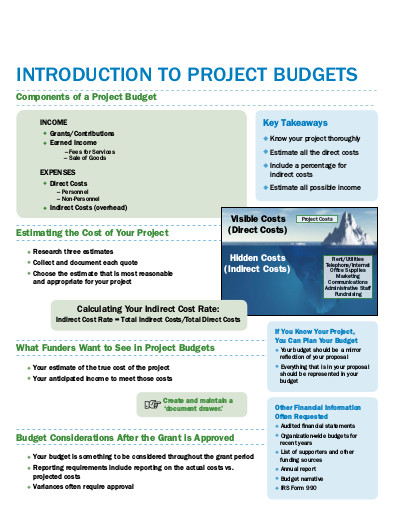
Size: 102 KB
Formulating a project budget is a tedious task. It becomes immensely tough for a fresher to identify varied parameters necessary for inclusion in a budget. Sometimes it is also difficult to interpret technical terminologies in a budget. This file is a basic guide on preparing a project budget.
Sound Project Budget Sample
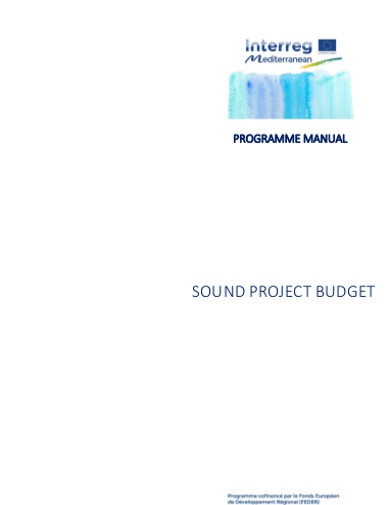
Size: 484 KB
It is advised that the budget of the project should be prepared in accordance with the real cost principle so that the budget can accomplish principles of the adequacy of costs and sound financial management. This document is an in detail guide to formulate a sound project budget. Download this file and refer to the key points before preparing a budget.
Project Budget Table

Size: 15 KB
Projects which takes years to complete has an intricate budget planned. Experts usually prefer to prepare such budgets in a table format. A table helps in accommodating all the important details and the entire bifurcated data for a project in a single sheet. This file is one such example of a complex budget in a table format.
Project Budget Summary
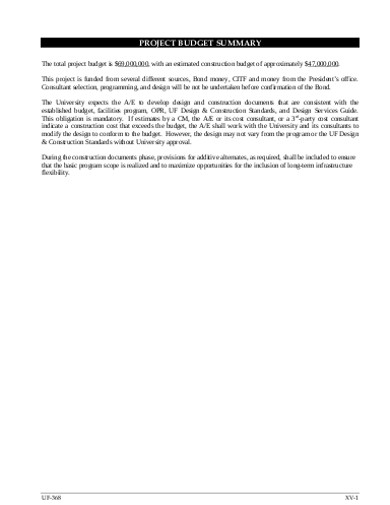
Size: 40 KB
A project budget undergoes multiple authorizations from senior management of a company to investors. After the initial approval of a project budget, a project summary is prepared to define the exact amount of required funds and the sources of the same. Such summaries are easy to understand and capture the entire life-cycle of the project. This file is a four-page project budget summary for a learner’s ready reference.
Project Budget Instructions
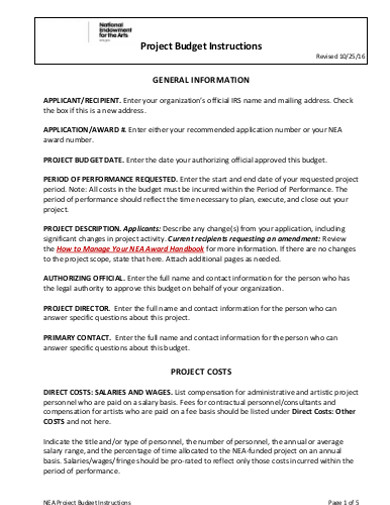
Size: 395 KB
It is important for a project budget to capture essential parameters of income and expense and at the same time also include organization details so that the document can be easily distinguished. In order to avoid non-inclusion of essential parameters and learn about the in & out of project budget download the above file.
Contingencies Allowances In Project Budgeting

Size: 460 KB
This file is a seven-page study aimed at establishing an empirical approach into the use of contingency allowances focused on substituting it with more focused budget structure. This study can help one in understanding concepts about project management, models, construction funds, and contingency allowances.
Setting up a Research Project Budget
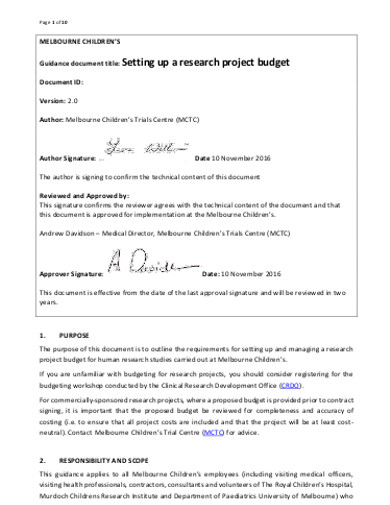
Size: 494 KB
A research project budget is a detailed summary of expected income and expense for the project duration. It can help in tracking the actual cost when the project is live and helps in maintaining the exact record of the funds. Download this seven-page report on the above mentioned subject to technically analyze different formats of preparing a project budget.
Project Budget Estimate
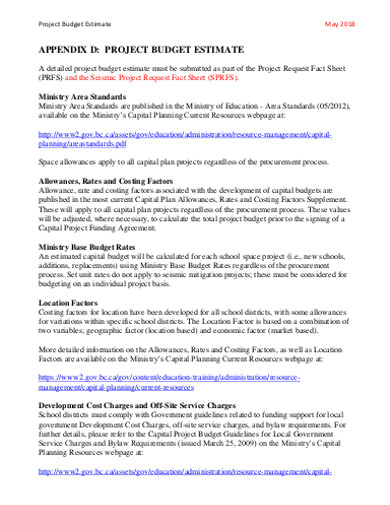
Size: 161 KB
This file is a document rolled out by a ministry, with clear instructions about techniques of developing a project budget estimate. Many companies roll out similar documents to ensure that the project budget report is as per the required standard and format of the company. Download this file to explore specific instructions on preparing a project budget estimate.
Preparing a Project Budget
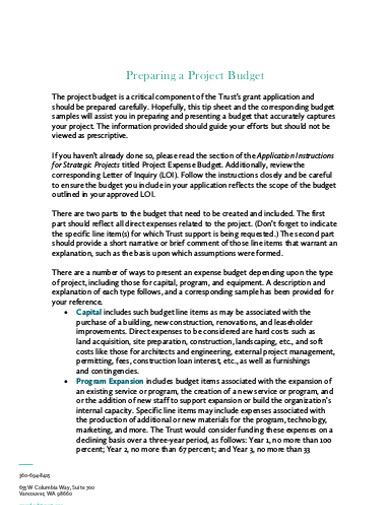
Size: 75 KB
Project budget is a critical component and is expected to be prepared carefully. This file provides tips and a corresponding budget sample so that one can accurately capture all the details in a budget . Download this file and issue a similar document to the employees responsible for project budget preparation in your company to minimize the chances of error.
President’s Prize Project Budget Template
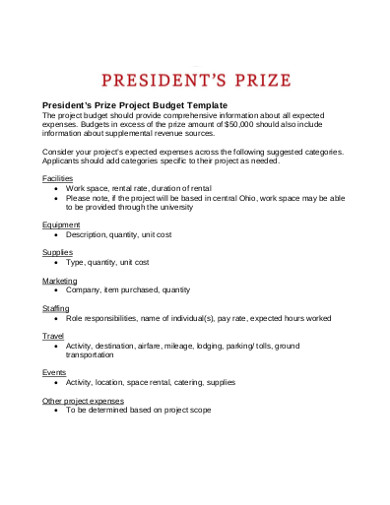
Size: 29 KB
This document is issued by an agency demanding comprehensive information about the expected budget on President’s prize project. It has included budget guidelines in the document and all the crucial parameters of expense. Download this file to understand diverse parameters of project budgeting.
Text prompt
- Instructive
- Professional
10 Examples of Public speaking
20 Examples of Gas lighting

- Quick Order
- Discovery & Translational Research
- Diagnostics & Clinical Research
- Human ID & Forensics
- Next-Generation Sequencing
- Instruments & Automation
- Informatics & Data
- OEM by QIAGEN
- Top Sellers
- DNA & RNA Purification
- Protein Purification
- Exosomes & CTCs
- Sample Collection & Stabilization
- PCR/qPCR/dPCR
- Custom LNA Oligonucleotides
- Pyrosequencing
- ISH & Northern Blotting
- Epigenetics
- Functional & Cell Analysis
- Lab Essentials
- GeneGlobe Design & Analysis Hub
RNeasy Mini Kit
High-quality total RNA in minutes.
Smart ideas, deep insights
Get inspiring content today – with a free face mask.
- TB Management
QuantiFERON-TB Gold Plus
- QuantiFERON Transplant
- artus Viral Load
- Infectious Disease
- QIAstat-Dx Syndromic Testing
- therascreen Solid Tumor
- ipsogen Leukemia
- Circulating Tumor Cells
- Sexual & Reproductive Health
- Cervical Cancer Screening
- Maternal/Fetal Testing
- STI Testing
Sample Processing
Solutions for laboratory-developed tests.
- Sample Collection
- Investigator Solutions
- Human DNA Quantification
- STR Technology
Investigator 24plex QS Kit
Multiplex amplification for human ID, with CODIS and European standard markers.
- GeneReader NGS System
- Nucleic Acid Purification
- PCR Instruments
- PCR Setup & Liquid Handling
- Quality Control & Fragment Analysis
- Service Solutions
- Accessories
- Analytics Software
- Automatable Kits
- Tissue Disruption
Monitor and manage your QIAsphere-ready instruments from anywhere, using any mobile device.
- DNA Sequencing
- RNA Sequencing
- Multianalyte Sequencing (Multimodal)
- Sample Quality Control
- Whole Genome/Transcriptome Amplification
- DNA Methylation Analysis
- Metagenomics
- Analysis & Visualization
- Interpretation & Content Databases
- Enterprise Solutions
QIAGEN Clinical Insight (QCI) Interpret
Transparent, evidence-based NGS interpretation and reporting.
Find out more
QIAGENbioinformatics.com
- OEM Reagents and Chemistries
- Point of Care Instruments
COVID-19 testing and research
Up to date protocols and list of COVID-19 testing and research solutions.
- Multianalyte & Virus
- Instruments & Equipment
- Crystallization
- Fractionation & Depletion
- Tagged Protein Expression, Purification, Detection
- Tissue/FFPE
- PCR Enzymes & Kits
- Real-Time PCR Enzymes & Kits
- qPCR Assays & Instruments
- Preamplification
- dPCR Assays Kits & Instruments
- Instruments
- Consumables
- Chromosome Conformation
- DNA Methylation
- Histone Modification
- ELISA Assays
- Gene Reporter Assays
- miRNA Functional Analysis
- RNA Silencing
- Transfection
- Buffers & Reagents
- Centrifuges
- Gel Electrophoresis
- Vacuum Manifolds & Accessories
- QIAcube Connect Kits
- QIAcube HT Kits
- QIAsymphony Kits
- Whole Genome Sequencing
- Whole Exome Sequencing
- Targeted DNA Panels
- Single Cell DNA
- Custom DNA Panels
- Whole Genome
- miRNA & Small RNAseq
- RNA Fusions
- Stranded RNAseq
- Targeted RNA Panels
- T-Cell Receptor Sequencing
- Single Cell RNA
- Ultraplex 3’ Targeted
- Ribosomal RNA & Globin mRNA Removal
- Custom RNA Panels
- Multimodal Panels
- Single Cell DNA/RNA
- Custom Multimodal Panels
- Single Cell & Low Input
- Whole Transcriptome
- Whole Genome Metagenomics
- Targeted Metagenomics
- Metatranscriptome Analysis
- End-Point PCR
- HiFidelity, Long-Range & Other PCR
- One-Step RT-PCR
- Reverse Transcription & cDNA Synthesis
- Probe-Based One-Step qRT-PCR
- Probe-Based qPCR
- Reverse Transcription & cDNA Synthesis for qPCR
- SYBR Green- or Dye-Based One-Step qRT-PCR
- SYBR Green- or Dye-Based qPCR
- CNV qPCR Assays & Arrays
- Microbial DNA qPCR Assays & Panels
- miRNA qPCR Assay & Panels
- mRNA/IncRNA qPCR Assays & Panels
- Somatic Mutations qPCR Assays & Panels
- Food Safety Testing
- Preamplification Kits
- dPCR Instruments
- dPCR Assays
- dPCR Accessories
- Bisulfite Conversion Assays
- Methylation-Specific PCR
- Cell-Free DNA
- DNA Clean Up
- Genomic DNA
- Microbial DNA
- Plasmid DNA
- Cell-Free RNA
- Microbial RNA
- RNA Clean Up
Detect TB infection with confidence.
- Cancer Research
Digital PCR
- Molecular Biology Research
- GeneGlobe Design & Analysis
- Next-generation sequencing
- Genomic Services
- Liquid Biopsy
- Partnering for Precision Diagnostics
- Plant Research
Digital is the new absolute
- Knowledge & Support Overview
Service Contact Center
- Events & Webinars
- Knowledge Hub
- Quality & Safety Data
Product & Technical Support
Ordering Support
Contact details for order support and technical support.
- Order Support Contact
- Technical Support Contact
- Service Agreements
- QIAlab Consulting
- One-Time Services
- Professional Services
- Stories & Insights
- Virtual Events
- Videos & Animations
- Virtual Demos
- Bench Guide
- Technology & Research
- Technologies & Research Topics
- Explainer Videos and Demos
- Events and Webinars
Learning Hub
Explore resources, including product documentation, software, webinars, videos, virtual demos and more.
- Certificate of Analysis
- Safety Data Sheets
- Quality Assurance
- GHS Hazard Labeling
- Protein Crystallization Production Reports
- QIAGEN Exclusion Database Service
Find quality and safety documentation for your products.
- Troubleshooting Guide
- Product FAQ
- Troubleshooting Molecular Biology Applications
- Product Selection Guides
- Product Finder
- New Lab Start-Up Program
- Green Packaging
Find out which products work together, search our FAQ database and troubleshoot.
- Marketplace Solutions
- Commercial Partner and Distributor Solutions
- Local Ordering
- Terms & Conditions
Learn about easy ordering options that offer fast and reliable delivery.
- Upcoming Live Sessions
- Webinars On-Demand
- Animal Cell Culture
- Whole Genome Amplification
- LNA Technology
- HRM Technology
- Plasmid Resource Center
- Pyrosequencing Resource Center
- Oncology Companion Diagnostics
- On-demand Sessions
- Digital PCR Technology
- Cancer – Unraveling the Complexities
- Reproducibility Through Automation
- RNA Resource Center
- Single Cell Analysis
- QuantiFERON Technology
- Biomarker Insights
- Digital Insights
- Customer Stories
- Investor Relations
- Sustainability
- Our Customers
- Our Products
- Our Global Presence
- Our History
Learn about who we are and what we do to make improvements in life possible.
- Meet the QIAGENers
- Your Path to QIAGEN
Join the QIAGEN team
Latest information on COVID-19
News, testing solutions and stories covering global efforts in the fight against COVID-19.
Our stories
Explore our digital magazine full of customer stories and videos on scientific breakthroughs and healthcare advances.
Market Strategy
Read our equity story, financial disclosures and how we create shareholder value.
- Executive Committee
- Supervisory Board
- Scientific Advisory Board
Latest News
Read up on our latest press releases or peruse our various media archives.
- Environment
- A letter from the CEO
- Order Support
- Technical Questions
- Human Resources
- Business Development
- Pharmaceutical Industry
- Media Inquiries
- Investor Relations Contacts
- Website Feedback
- Global Contacts
Thank you for choosing QIAGEN. If you have questions about QIAGEN, our products or your order, this page should help you find the answers and contacts you need.
- QIAGEN Subsidiaries
- QIAGEN Divisions
Press Release
Qiagen and myriad genetics develop distributable homologous recombination deficiency test for global research and companion diagnostics applications, further information, weitere informationen.
- Next-generation-sequencing-based homologous recombination deficiency (HRD) assay based on QIAGEN’s QIAseq xHYB technology, QIAGEN Digitial Insight solutions, and Myriad’s proprietary, FDA-approved MyChoice CDx® biomarkers
- QIAGEN to make kit-based HRD test available globally to support research and companion diagnostics development in collaboration with pharmaceutical partners enabling wider adoption and potential clinical indication expansion for MyChoice CDx
- Project builds on recently announced master collaboration agreement between the two companies
Venlo, the Netherlands, and Salt Lake City, Utah, May 30, 2024 (GLOBE NEWSWIRE) -- QIAGEN (NYSE: QGEN; Frankfurt Prime Standard: QIA) and Myriad Genetics (NASDAQ: MYGN) today announced they will develop a globally distributable kit-based test for analyzing Homologous Recombination Deficiency (HRD) status. This next-generation sequencing (NGS) test aims to support research into personalized medicine in multiple solid tumor types, including ovarian cancer and is expected to enhance decentralized testing capacities once a regulated product is developed with pharmaceutical partners. The project builds on the recently announced master collaboration agreement between the two companies.
The test will be based on QIAGEN’s QIAseq xHYB technology, QIAGEN Digital Insight solutions, which creates a sample to insight HRD solutions, and Myriad’s proprietary FDA-approved MyChoice CDx, a single-site PMA-approved centralized testing service for analyzing HRD in certain tumors. MyChoice CDx assesses the HRD status by examining a tumor’s DNA repair capabilities, particularly focusing on BRCA1 and BRCA2 gene mutations and calculating a Genome Instability Score (GIS). The GIS aids in pinpointing ovarian cancer patients who are most likely to benefit from targeted treatments, such as LYNPARZA® (olaparib) by AstraZeneca.
“Our partnership with Myriad Genetics underscores a shared commitment to advancing cancer diagnostics. Together, we aim to broaden the accessibility of HRD tests, allowing an increasing number of cancer patients to benefit from tailored treatments,” said Fernando Beils, Senior Vice President and head of the Molecular Diagnostics Business Area. “By introducing a distributable HRD test, we anticipate a reduction in the time required for therapy decisions, a decrease in associated costs, and shorter turnaround times compared to outsourced testing, ultimately benefitting the patients.”
The MyChoice CDx assay can identify 34% more tumors with HRD using the GIS score compared to other methods only using percent loss of heterozygosity (%LOH) [1] . Given that approximately 48% of ovarian cancer tumors exhibit HRD [2] , often due to specific mutations within the tumor, expanding access to this assay is vital for advancing personalized medicine and ensuring that patients receive the most appropriate treatments.
We’re excited to share this milestone in our partnership with QIAGEN as we work collectively to advance cancer care worldwide,” said Patrick Burke, Executive Vice President of Strategy and Innovation, Myriad Genetics. “By extending the global reach and ease of access to Myriad’s gold-standard HRD-testing technology we aim to help drive wide-spread and broader clinical adoption of HRD testing. This milestone demonstrates what the QIAGEN and Myriad partnership is uniquely able to deliver to pharmaceutical partners – propriety content, cutting edge assay platforms, clinical trial execution, and world-wide CDx product distribution.”
QIAGEN will manage the development and distribution of the kit-based HRD test outside of the United States. The IP license grants QIAGEN the capability to collaborate with pharmaceutical partners to create an IVD-validated test, intended for use as a companion diagnostic outside of the United States. The combined regulatory expertise of QIAGEN and Myriad enables seamless compliance and integration in clinical and companion diagnostic applications.
QIAGEN’s QIAseq panels enable efficient and accurate NGS library preparation. Over 4 million samples have been processed with QIAseq panels for cancer testing applications. [3]
QIAGEN has master collaboration agreements to develop and commercialize companion diagnostics with more than 30 global pharma and biotech companies – a deep pipeline that helps advance precision medicine in diverse disease indications, tailoring a patient’s treatment to the genetic profile identified by companion diagnostics testing. Myriad has provided testing support for hundreds of clinical trials, has obtained 10 companion diagnostic approvals from the FDA and PMDA, and anticipates that the QIAGEN partnership will drive the expansion of the Myriad’s oncology products portfolio.
About Myriad Genetic s
Myriad Genetics is a leading genetic testing and precision medicine company dedicated to advancing health and well-being for all. Myriad develops and offers genetic tests that help assess the risk of developing disease or disease progression and guide treatment decisions across medical specialties where genetic insights can significantly improve patient care and lower healthcare costs. For more information, visit www.myriad.com .
About QIAGEN
QIAGEN N.V., a Netherlands-based holding company, is the leading global provider of Sample to Insight solutions that enable customers to gain valuable molecular insights from samples containing the building blocks of life. Our sample technologies isolate and process DNA, RNA and proteins from blood, tissue and other materials. Assay technologies make these biomolecules visible and ready for analysis. Bioinformatics software and knowledge bases interpret data to report relevant, actionable insights. Automation solutions tie these together in seamless and cost-effective workflows. QIAGEN provides solutions to more than 500,000 customers around the world in Molecular Diagnostics (human healthcare) and Life Sciences (academia, pharma R&D and industrial applications, primarily forensics). As of March 31, 2024, QIAGEN employed approximately 5,900 people in over 35 locations worldwide. Further information can be found at http://www.qiagen.com .
Forward-Looking Statement
Certain statements contained in this press release may be considered forward-looking statements within the meaning of Section 27A of the U.S. Securities Act of 1933, as amended, and Section 21E of the U.S. Securities Exchange Act of 1934, as amended, including statements relating to the development of a globally distributable kit-based test for analyzing HRD status and the anticipated benefits of the Myriad and QIAGEN partnership, including that the partnership may drive the expansion of Myriad’s oncology products portfolio and enable potential clinical indication expansion for MyChoice CDx. To the extent that any of the statements contained herein relating to QIAGEN's products, timing for launch and development, marketing and/or regulatory approvals, financial and operational outlook, growth and expansion, collaborations, markets, strategy or operating results, including without limitation its expected adjusted net sales and adjusted diluted earnings results, are forward-looking, such statements are based on current expectations and assumptions that involve a number of uncertainties and risks. Such uncertainties and risks include, but are not limited to, risks associated with management of growth and international operations (including the effects of currency fluctuations, regulatory processes and dependence on logistics), variability of operating results and allocations between customer classes, the commercial development of markets for our products to customers in academia, pharma, applied testing and molecular diagnostics; changing relationships with customers, suppliers and strategic partners; competition; rapid or unexpected changes in technologies; fluctuations in demand for QIAGEN's products (including fluctuations due to general economic conditions, the level and timing of customers' funding, budgets and other factors); our ability to obtain regulatory approval of our products; difficulties in successfully adapting QIAGEN's products to integrated solutions and producing such products; the ability of QIAGEN to identify and develop new products and to differentiate and protect our products from competitors' products; market acceptance of QIAGEN's new products and the integration of acquired technologies and businesses; actions of governments, global or regional economic developments, weather or transportation delays, natural disasters, political or public health crises, and its impact on the demand for our products and other aspects of our business, or other force majeure events; as well as the possibility that expected benefits related to recent or pending acquisitions may not materialize as expected; and the other factors discussed under the heading “Risk Factors” contained in Item 3 of our most recent Annual Report on Form 20-F. For further information, please refer to the discussions in reports that QIAGEN has filed with, or furnished to, the U.S. Securities and Exchange Commission.
Any “forward-looking statements” relating to Myriad or the development of a globally distributable kit-based test for analyzing HRD status are Myriad's management’s expectations of future events as of the date hereof and are subject to known and unknown risks and uncertainties that could cause actual results, conditions, and events to differ materially and adversely from those anticipated. Such factors include those risks described in Myriad’s filings with the U.S. Securities and Exchange Commission, including Myriad’s Annual Report on Form 10-K filed on February 28, 2024, as well as any updates to those risk factors filed from time to time Myriad’s Quarterly Reports on Form 10-Q or Current Reports on Form 8-K. Myriad is not under any obligation, and it expressly disclaims any obligation, to update or alter any forward-looking statements, whether as a result of new information, future events or otherwise except as required by law.
[1] Timms, et al. JClinOnc 2020 38:15_suppl, 1586-1586. [2] Moore et. al, Lancet Oncol 2019 [3] QIAseq products are intended for molecular biology applications. These products are not intended for the diagnosis, prevention, or treatment of a disease.
Contacts Myriad:
Matt Scalo +1-801-584-3532 [email protected]
Glenn Farrell +1-385-318-3718 [email protected]
Multimedia Files:
Press Contacts

Daniela Berheide Associate Director Public Relations
Germany: +49 2103 29 11676
Mobile: +49 152 01811676

Lisa Mannagottera Manager Public Relations
Germany: +49 2103 29 14181
Mobile: +49 152 01811381
Download VCARD

Dr. Thomas Theuringer Senior Director Corporate Communications & Head Of External
Germany: +49 2103 29 11826
U.S.: +1 240 686 7425
The Netherlands: +31 773 55 66 66
IR Contacts

Domenica Martorana Associate Director Global Investor Relations
Germany +49 2103 29 11244
Mobile +49 152 018 11244
+49 2103 29 11244

Alexandra Koenig Investor Relations Coordinator
Germany +49 2103 29 11709
Mobile +49 152 018 11709

John Gilardi Vice President Head of Corporate Communications and Investor Relations
Germany +49 2103 29 11711
Mobile +49 152 018 11711
U.S. +1 240 686 2222
The Netherlands +31 773 55 66 66
Email Alerts
To opt-in for investor email alerts, please enter your email address in the field below and select at least one alert option. After submitting your request, you will receive an activation email to the requested email address. You must click the activation link in order to complete your subscription. You can sign up for additional alert options at any time.
At QIAGEN N.V., we promise to treat your data with respect and will not share your information with any third party. You can unsubscribe to any of the investor alerts you are subscribed to by visiting the ?unsubscribe? section below. If you experience any issues with this process, please contact us for further assistance.
By providing your email address below, you are providing consent to QIAGEN N.V. to send you the requested Investor Email Alert updates.
Um sich für E-Mail-Benachrichtigungen für Anleger anzumelden, geben Sie bitte Ihre E-Mail-Adresse in das unten stehende Feld ein und wählen Sie mindestens eine Benachrichtigungsoption aus. Nach dem Absenden Ihrer Anfrage erhalten Sie eine Aktivierungs-E-Mail an die angegebene E-Mail-Adresse. Sie müssen den Aktivierungslink anklicken, um Ihr Abonnement abzuschließen. Sie können sich jederzeit für weitere Benachrichtigungsoptionen anmelden.
QIAGEN N.V. verpflichtet sich, Ihre Daten mit Respekt zu behandeln und sie nicht an Dritte weiterzugeben. Sie können alle von Ihnen abonnierten Investor Alerts abbestellen, indem Sie den unten stehenden Abschnitt "Abbestellen" besuchen. Sollten Sie Probleme mit diesem Vorgang haben, wenden Sie sich bitte an uns, um weitere Unterstützung zu erhalten.
Durch die Angabe Ihrer E-Mail-Adresse erklären Sie sich damit einverstanden, dass QIAGEN N.V. Ihnen die angeforderten Investor Email Alert Updates zusendet.
* Erforderlich
Email Alert Sign Up Confirmation
Anmeldebestätigung e-mail-alarm.
- linkedin open in new window
- facebook open in new window
- twitter open in new window
- youtube open in new window
This site is protected by reCAPTCHA and the Google Privacy Policy and Terms of Service apply.
Sample to Insight
- Trademarks & Disclaimers
- Privacy Policy
- Accessibility

IMAGES
VIDEO
COMMENTS
Research proposal examples. Writing a research proposal can be quite challenging, but a good starting point could be to look at some examples. We've included a few for you below. Example research proposal #1: "A Conceptual Framework for Scheduling Constraint Management" Example research proposal #2: "Medical Students as Mediators of ...
A research proposal is a document that outlines your proposed research project, explaining what you plan to study, why it's important and how you will conduct your research. A well-structured research proposal includes a title page, abstract and table of contents, introduction, literature review, research design and methodology, contribution to ...
Detailed Walkthrough + Free Proposal Template. If you're getting started crafting your research proposal and are looking for a few examples of research proposals, you've come to the right place. In this video, we walk you through two successful (approved) research proposals, one for a Master's-level project, and one for a PhD-level ...
17 Research Proposal Examples. By Chris Drew (PhD) | January 12, 2024. A research proposal systematically and transparently outlines a proposed research project. The purpose of a research proposal is to demonstrate a project's viability and the researcher's preparedness to conduct an academic study. It serves as a roadmap for the researcher.
Research proposal aims. Relevance. Show your reader why your project is interesting, original, and important. Context. Demonstrate your comfort and familiarity with your field. Show that you understand the current state of research on your topic. Approach. Make a case for your methodology. Demonstrate that you have carefully thought about the ...
Step 1: Find a topic and review the literature. As we mentioned earlier, in a research paper, you, as the researcher, will try to answer a question.More specifically, that's called a research question, and it sets the direction of your entire paper. What's important to understand though is that you'll need to answer that research question with the help of high-quality sources - for ...
Here is an explanation of each step: 1. Title and Abstract. Choose a concise and descriptive title that reflects the essence of your research. Write an abstract summarizing your research question, objectives, methodology, and expected outcomes. It should provide a brief overview of your proposal. 2.
Research Proposals including Research Plans ; Coming Up With a Research Question; Getting Ethics Approval; Struggling with a Literature Review; Qualitative, Quantitative or Mixed-Methods ; Data Collection; Working with Primary Data ; Using the Internet for Research; Data Management; Writing Up Your Research ; Preparing for the Research Project
The research topic is too broad (or just poorly articulated). The research aims, objectives and questions don't align. The research topic is not well justified. The study has a weak theoretical foundation. The research design is not well articulated well enough. Poor writing and sloppy presentation. Poor project planning and risk management.
A Sample Research Proposal with Comments A research project or thesis will take at least two semesters to complete. Prior to starting a research, i.e. enrolling in the first semester research course, students must go through the proposal stage, during which students will develop their proposal and have it reviewed by his/her research advisor. ...
Research Project is a planned and systematic investigation into a specific area of interest or problem, with the goal of generating new knowledge, insights, or solutions. It typically involves identifying a research question or hypothesis, designing a study to test it, collecting and analyzing data, and drawing conclusions based on the findings.
A research project for students is an extended essay that presents a question or statement for analysis and evaluation. During a research project, you will present your own ideas and research on a subject alongside analysing existing knowledge. How to write a research report The next section covers the research project steps necessary to ...
Here are real-life research proposal examples of funded research projects in the field of science and technology. Funder. Title. US Geological Survey (USGS) (Mendenhall Postdoctoral Research Fellowship) Using Integrated Population Modelling in Decision-support Tools to Connect Science and Decision Makers.
Sample Individual Research Projects. The following are individual research projects completed in the NRES online M.S. program that may be of use to current students preparing for this phase of their degrees. These alumni have granted permission for their project to be posted. These works may not be reproduced or redistributed without the author ...
Define your specific research problem and problem statement. Highlight the novelty and contributions of the study. Give an overview of the paper's structure. The research paper introduction can vary in size and structure depending on whether your paper presents the results of original empirical research or is a review paper.
Research methodology formats can vary depending on the specific requirements of the research project, but the following is a basic example of a structure for a research methodology section: I. Introduction. Provide an overview of the research problem and the need for a research methodology section; Outline the main research questions and ...
What's Included: Research Proposal Template. Our free dissertation/thesis proposal template covers the core essential ingredients for a strong research proposal. It includes clear explanations of what you need to address in each section, as well as straightforward examples and links to further resources. The research proposal template covers ...
PDF | On Feb 12, 2019, Maryfaith Nyakio published undergraduate project paper | Find, read and cite all the research you need on ResearchGate
The "Teaching Evolution through Human Examples" (TEtHE) three-year exploratory research and development project was funded by National Science Foundation Discovery Research K-12 grant #1119468.The project has created four curriculum units for Advanced Placement (AP) Biology classes, aligned to the learning objectives, using human case studies to teach core evolutionary principles.
Sample Patient Recruitment Flyer . ... recruitment flyer is an example of one way for practices to recruit patients for AHRQ's Managing Urinary Incontinence Project. Institution of origin. Birmingham Veterans Affairs (VA) Health Care System & Atlanta Veterans Affairs (VA) Health Care System ... Agency for Healthcare Research and Quality. 5600 ...
File Format. PDF. Size: 254 KB. Download. This file is a twenty-eight-page report on methodology to manage development projects for international humanitarian assistance and relief organizations. The report emphasizes and explains about controlling the project budget throughout the entire project life cycle.
QIAGEN N.V., a Netherlands-based holding company, is the leading global provider of Sample to Insight solutions that enable customers to gain valuable molecular insights from samples containing the building blocks of life. Our sample technologies isolate and process DNA, RNA and proteins from blood, tissue and other materials.